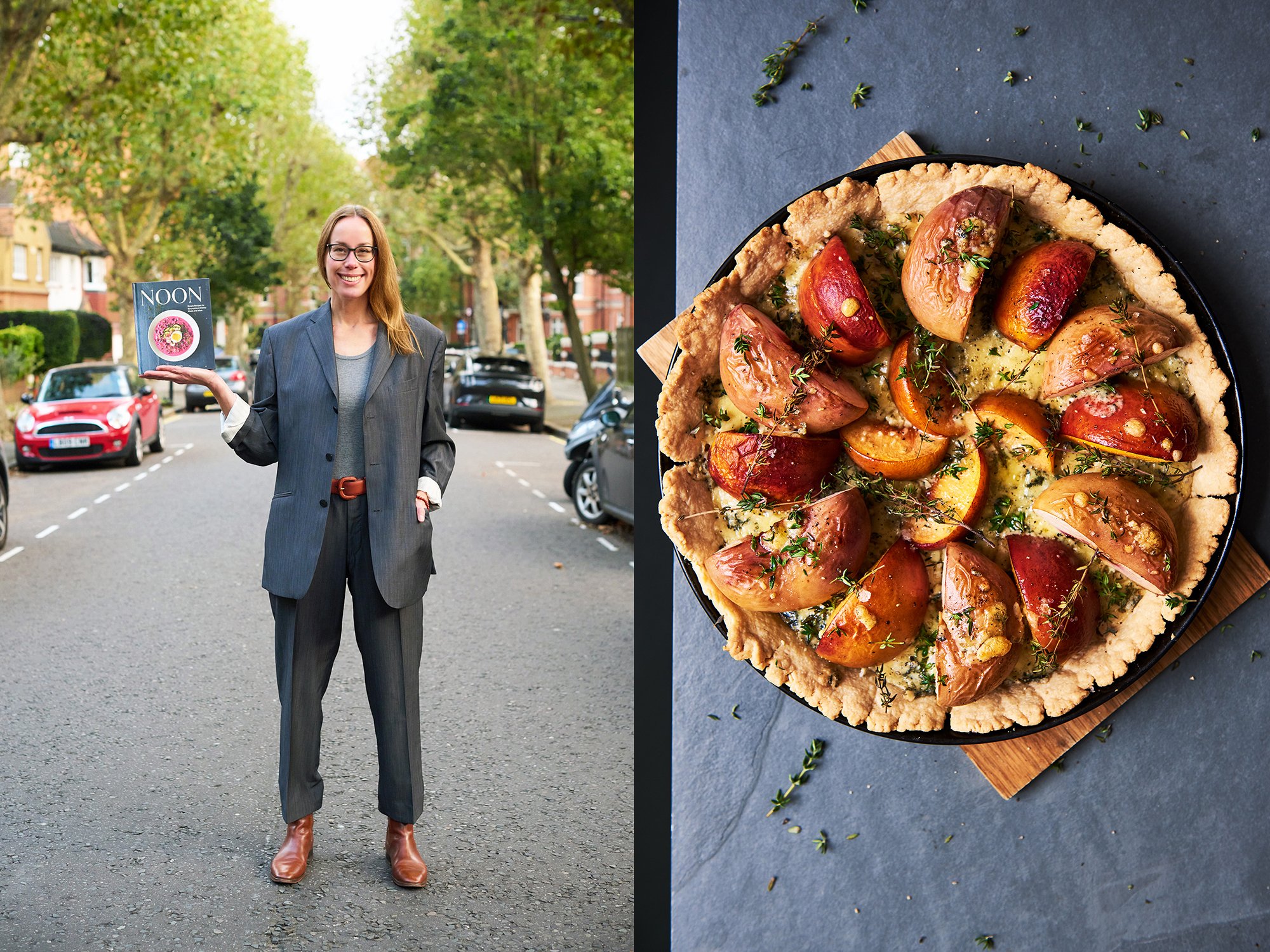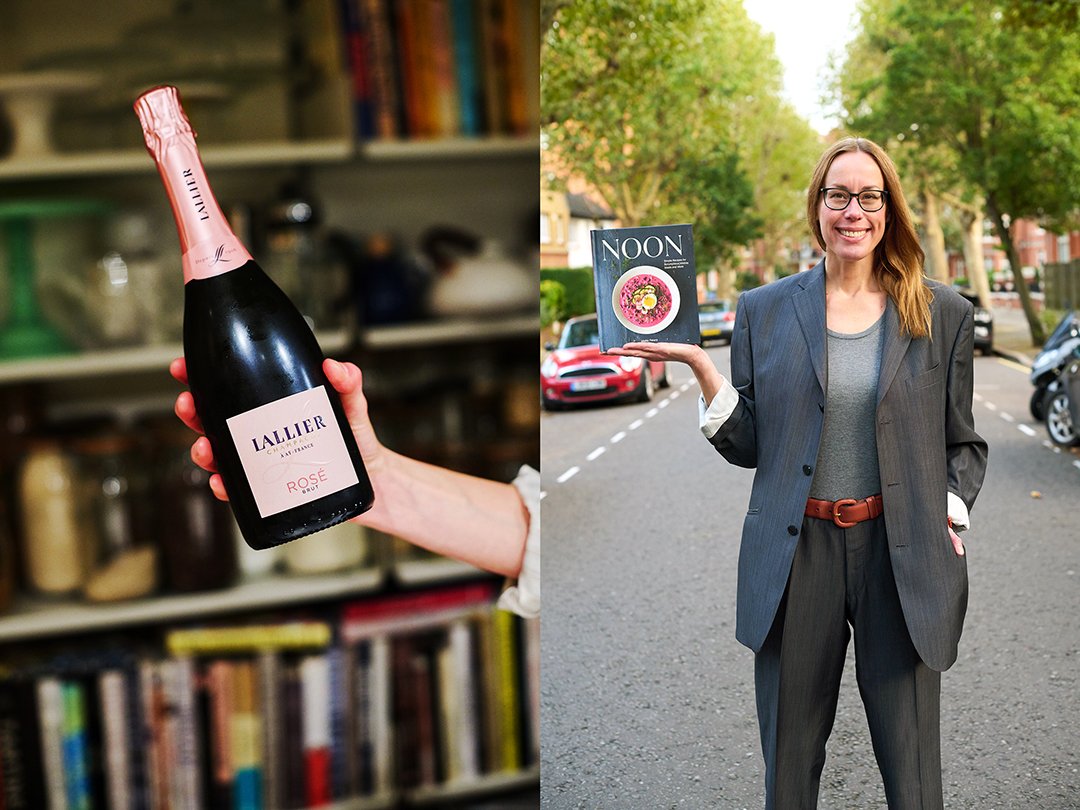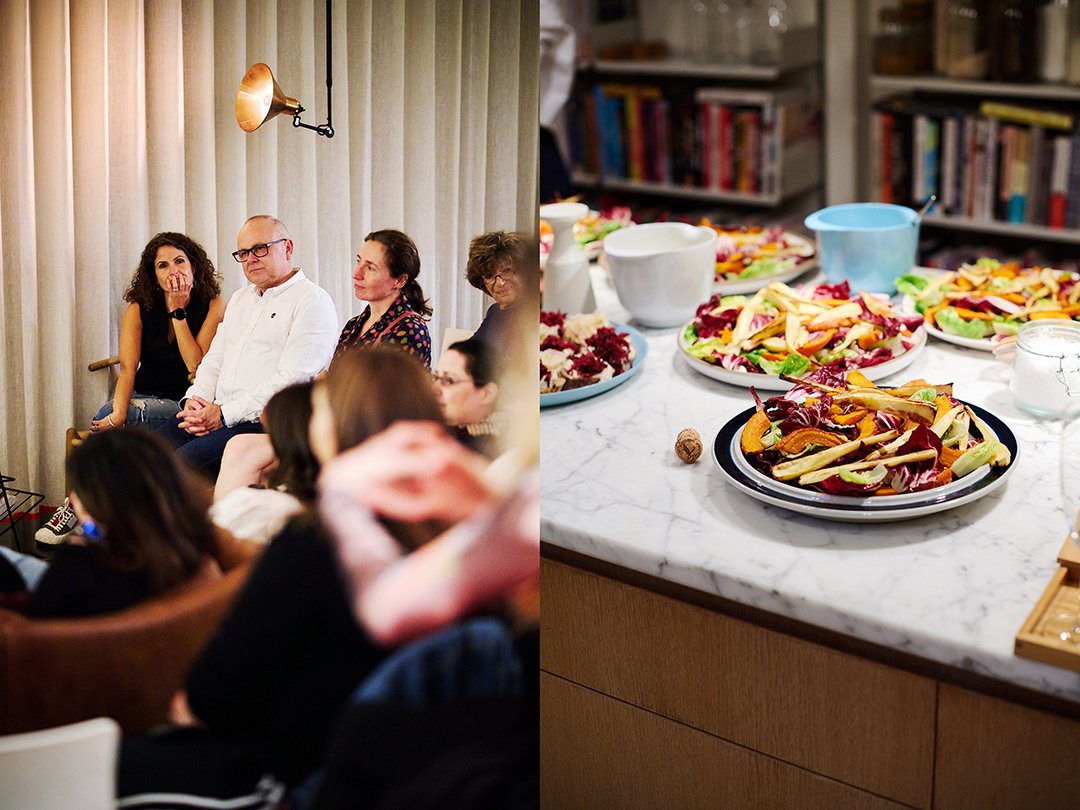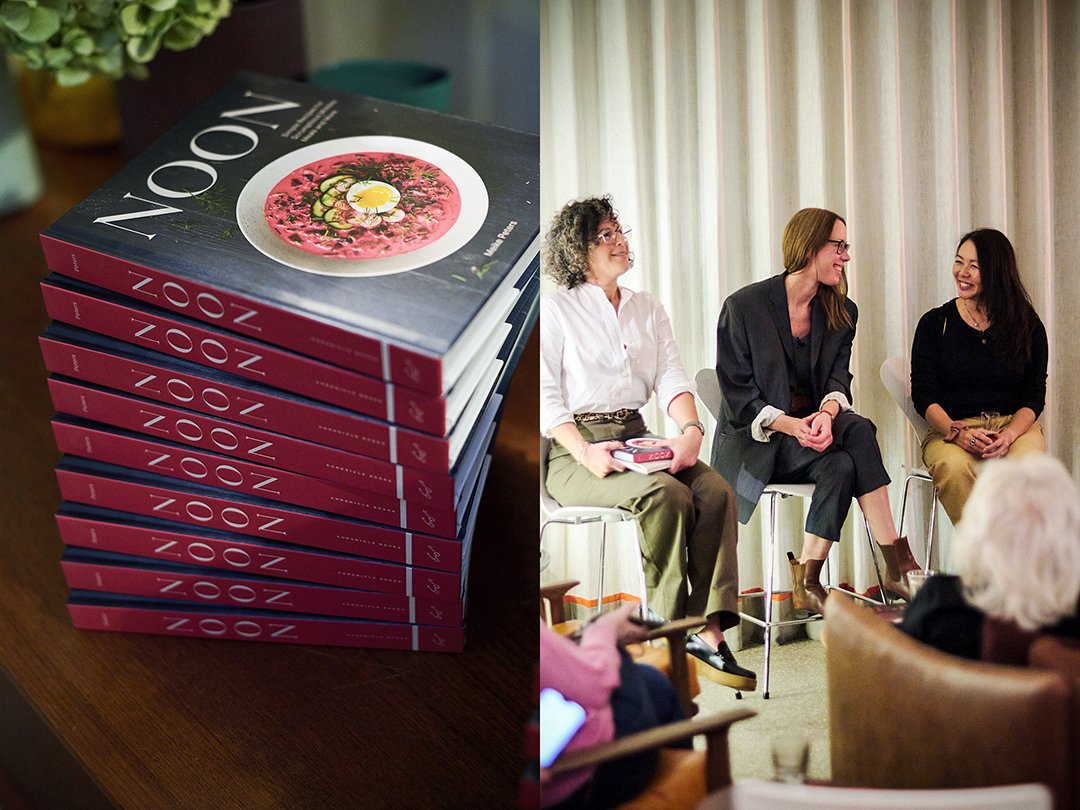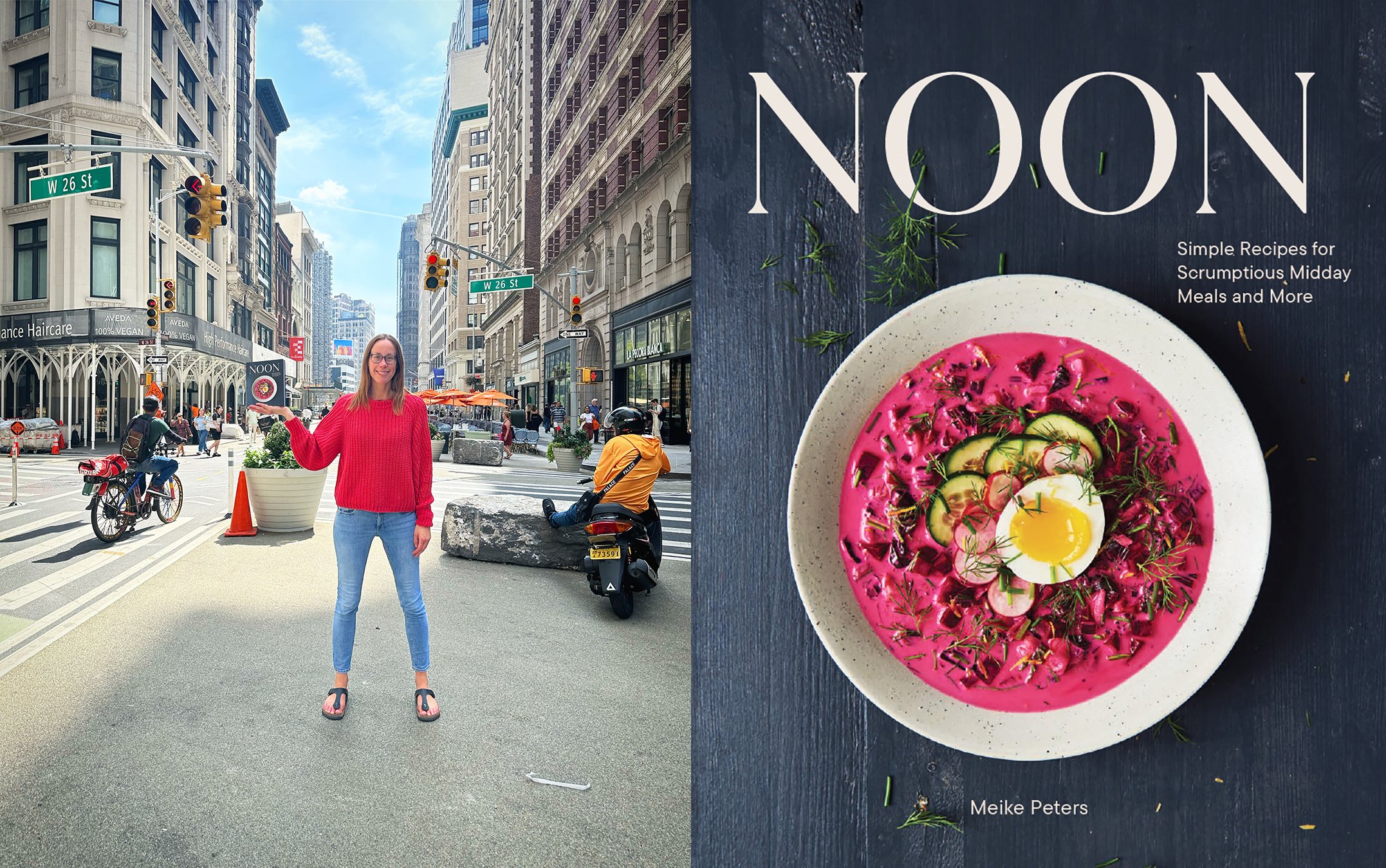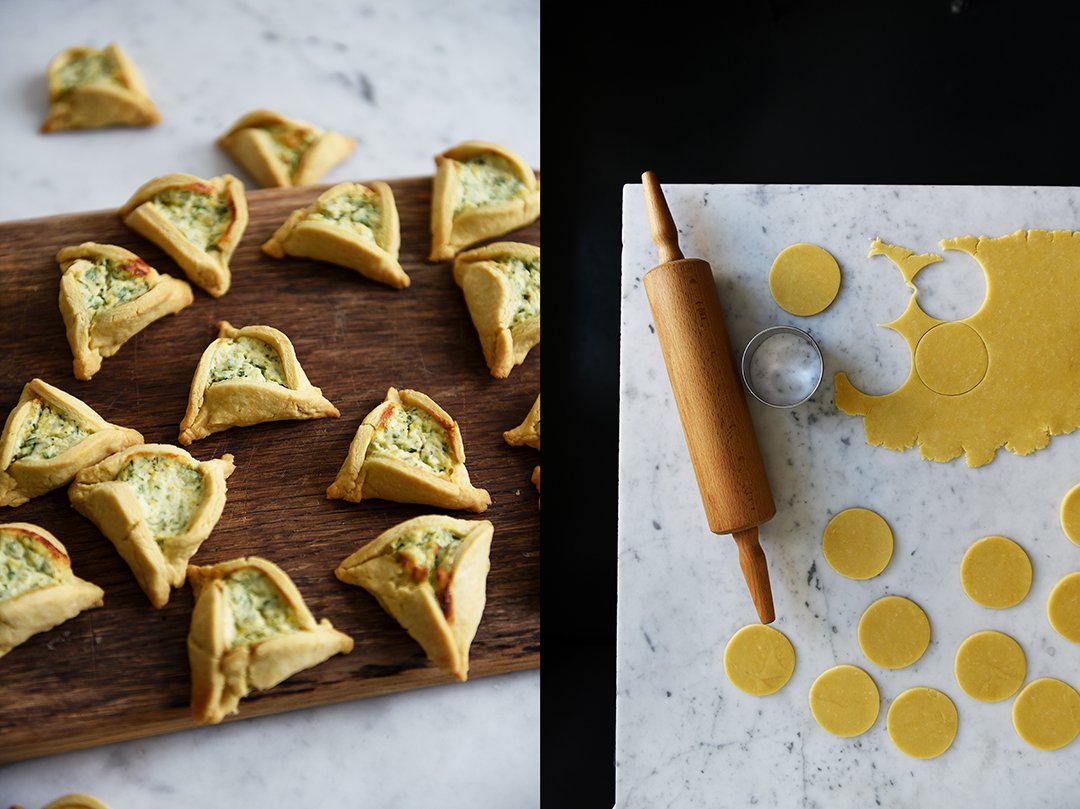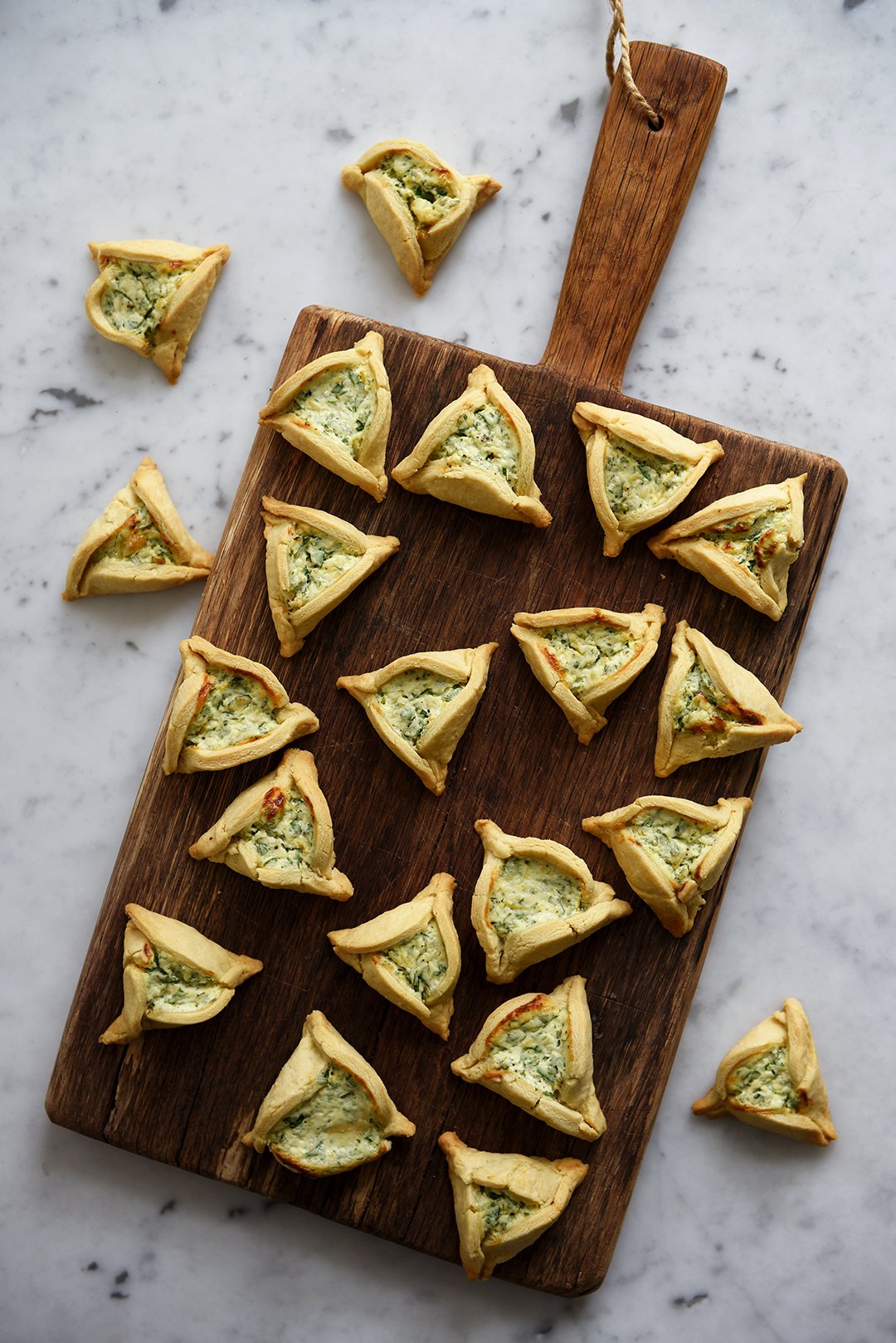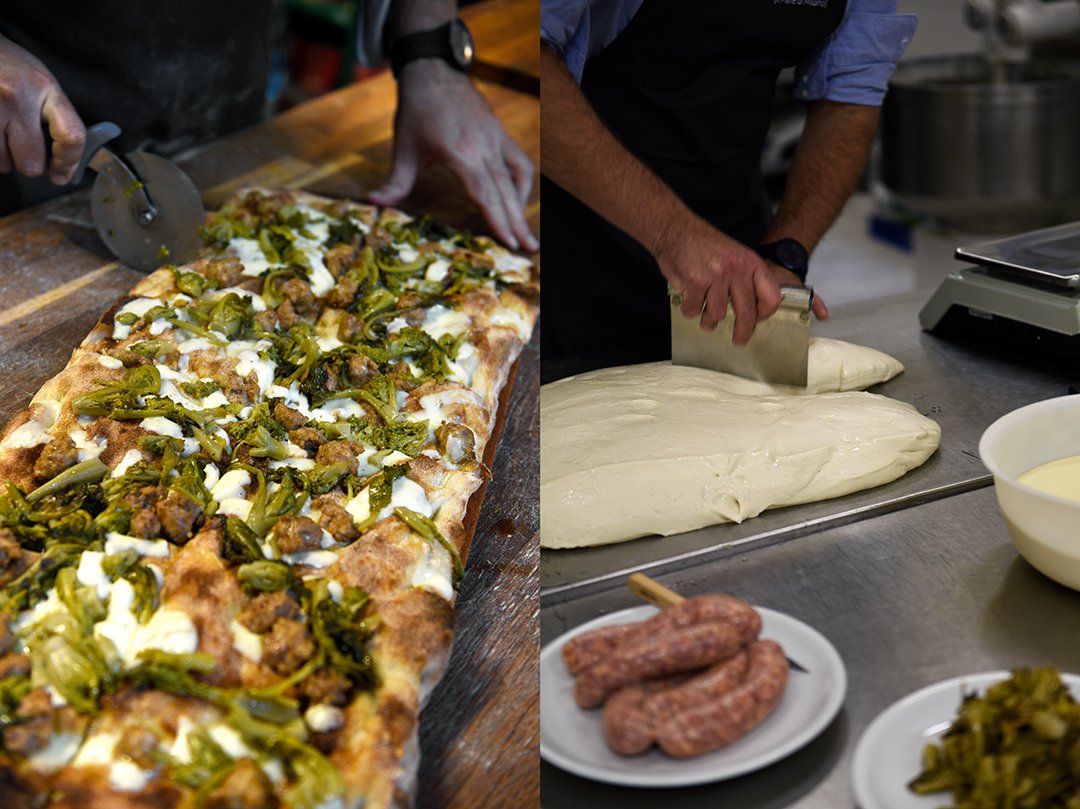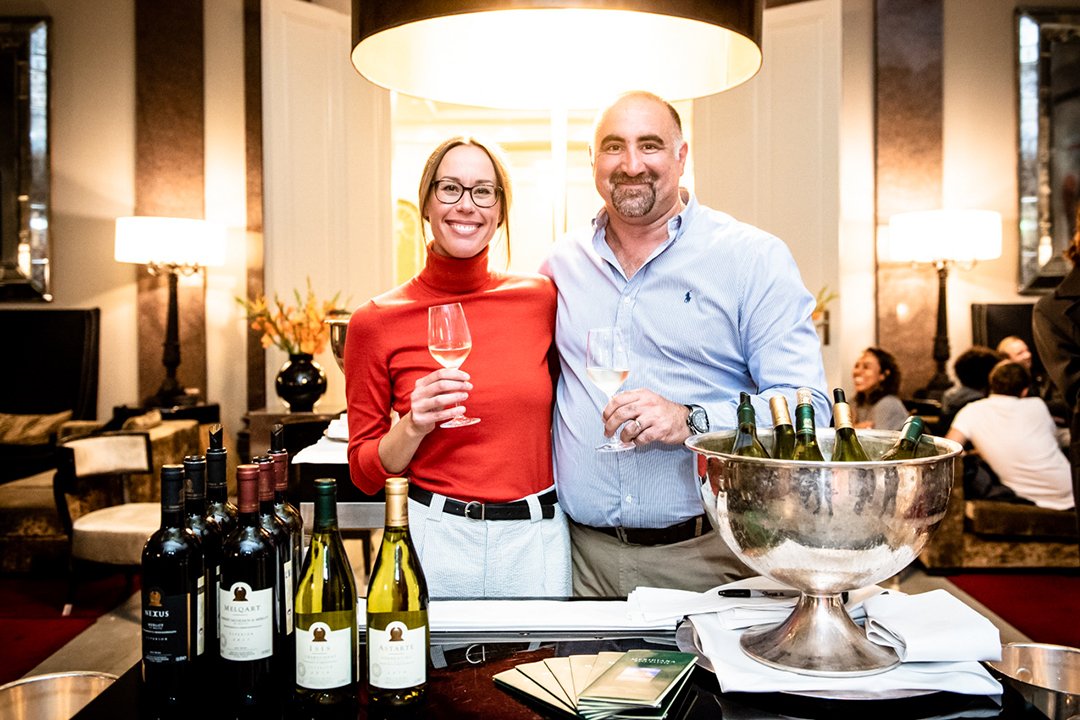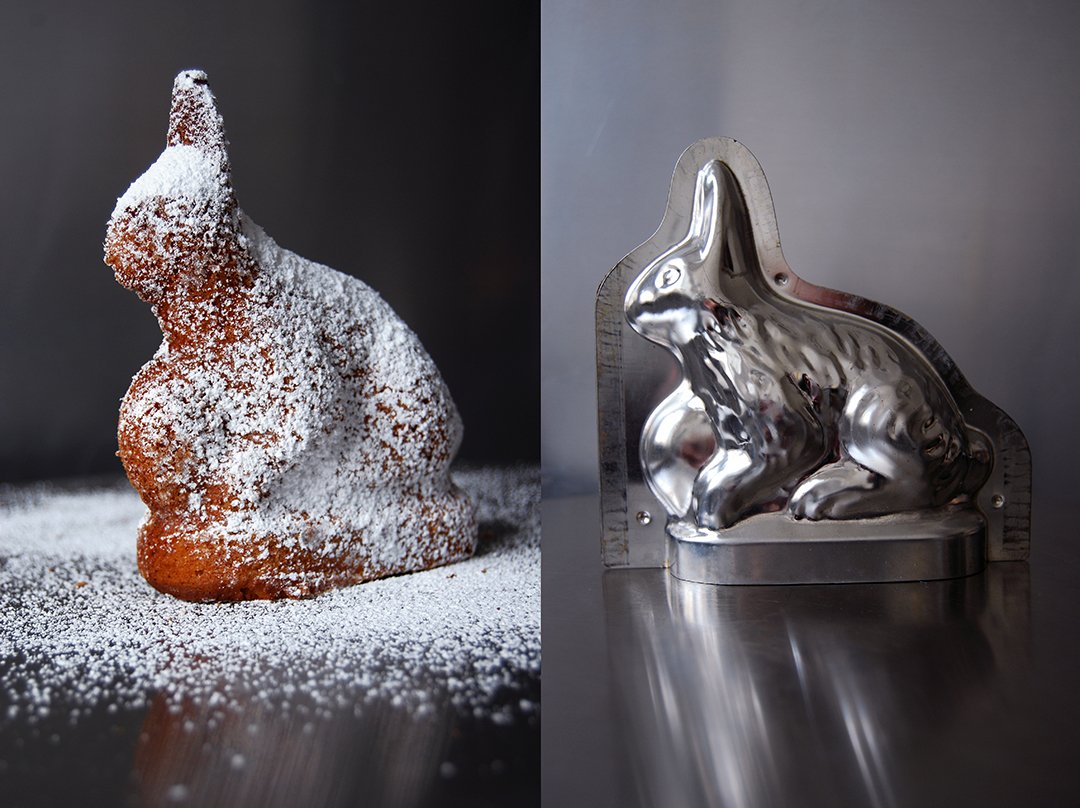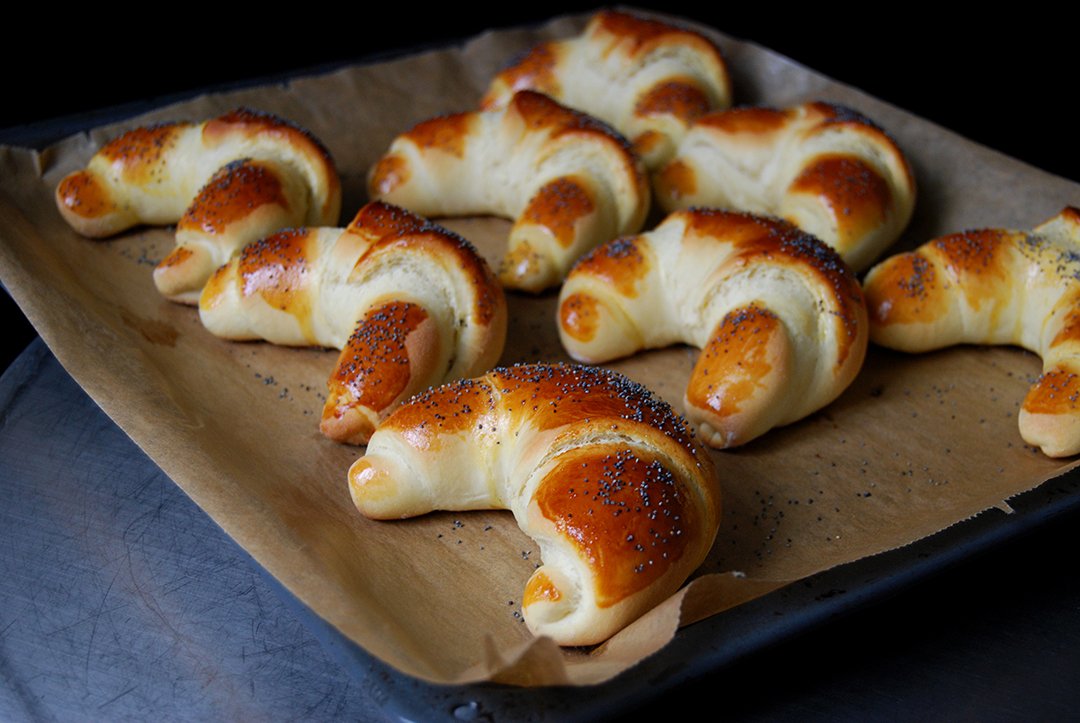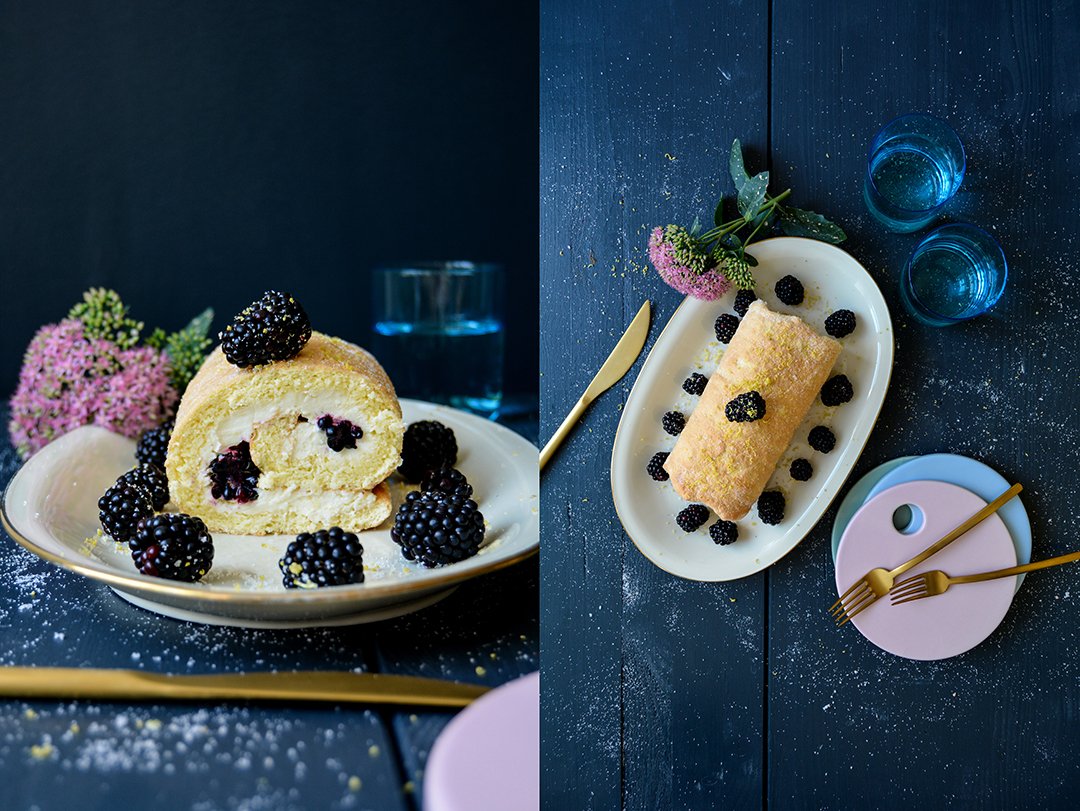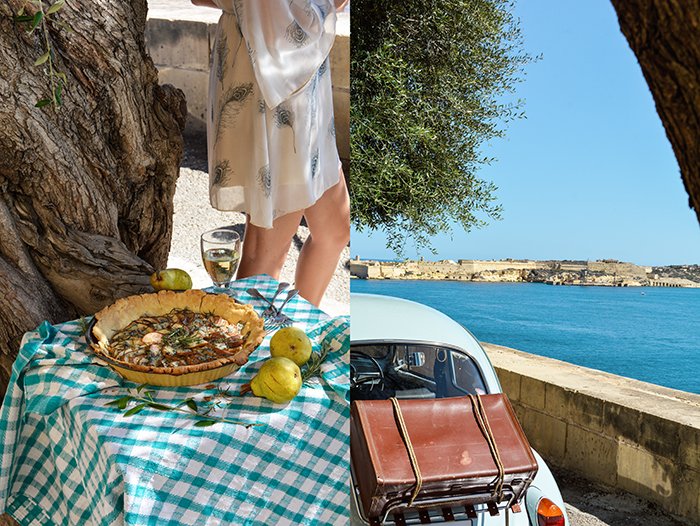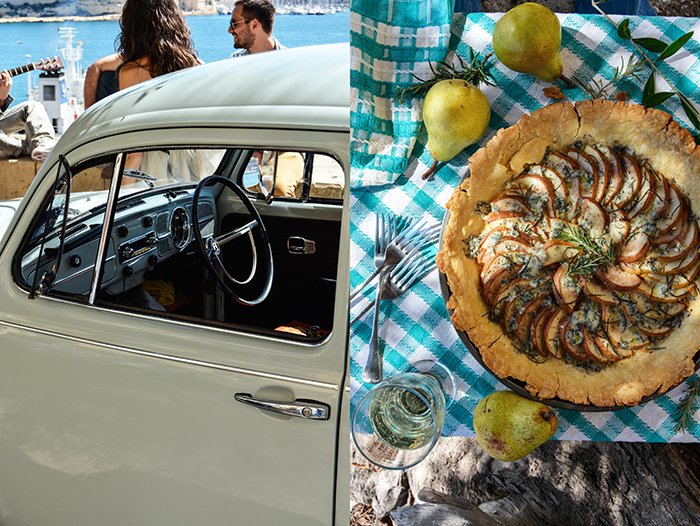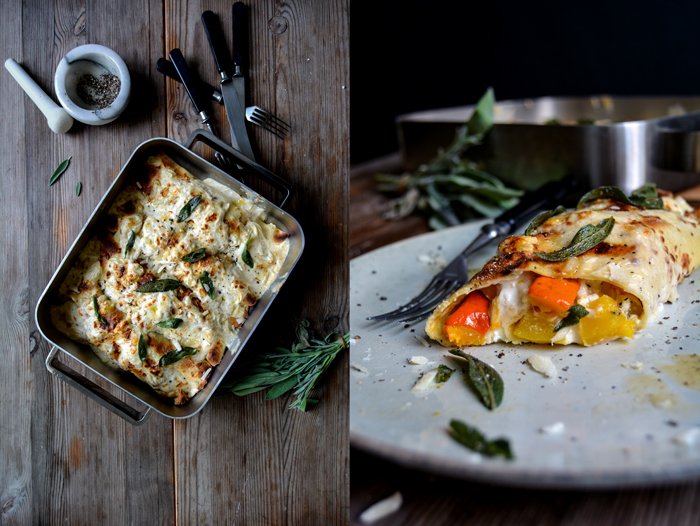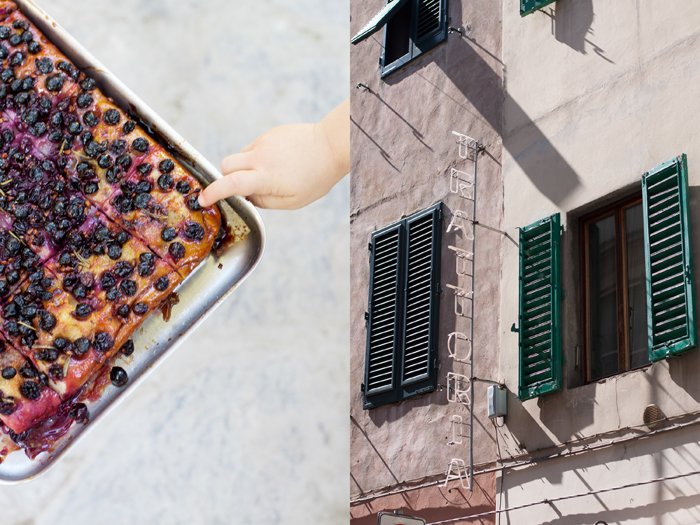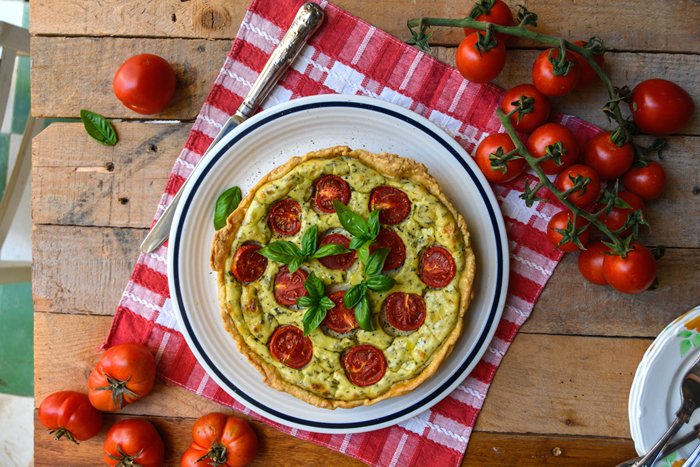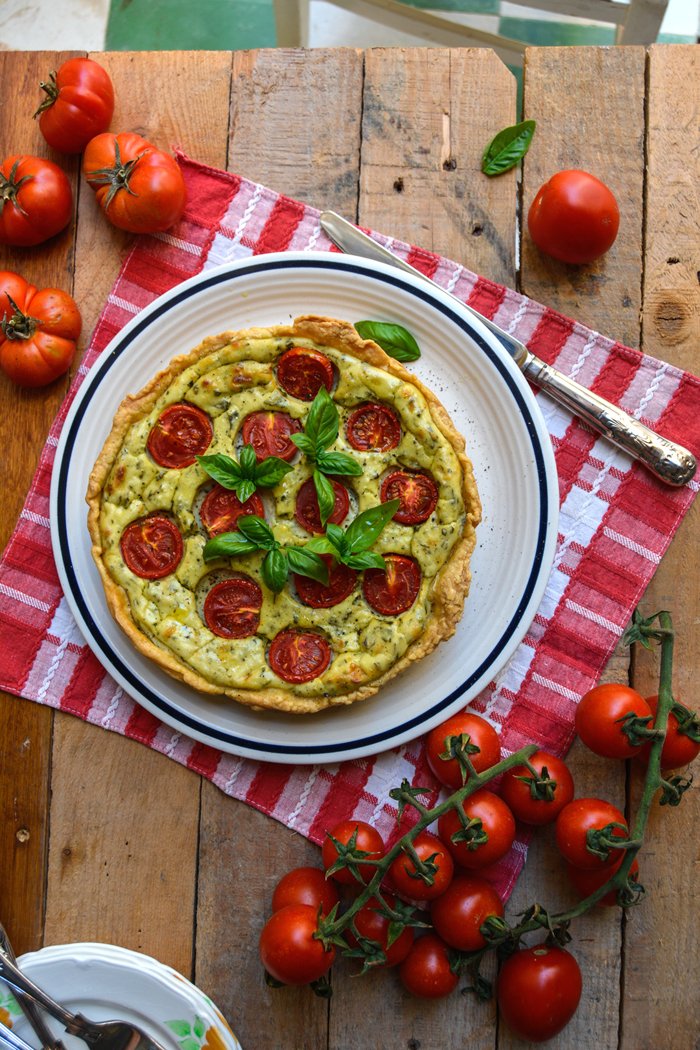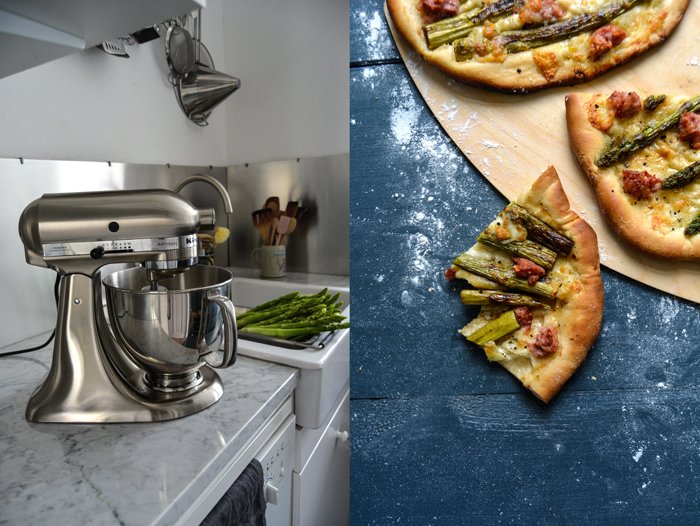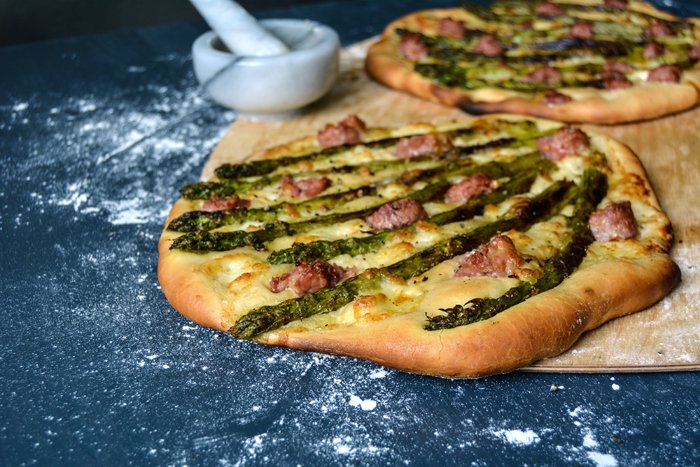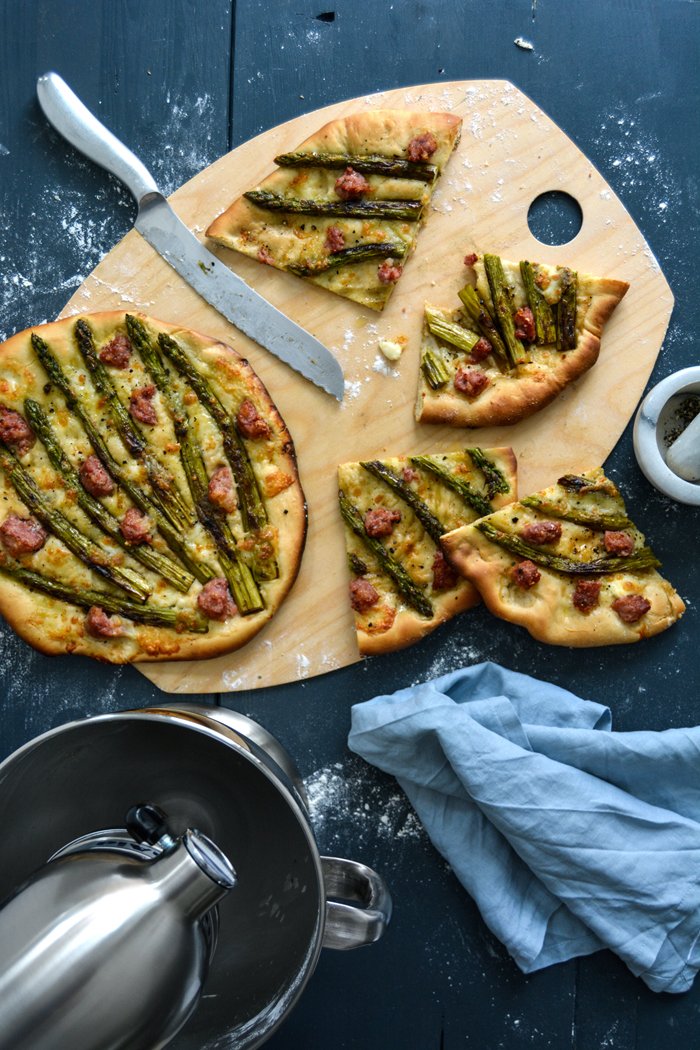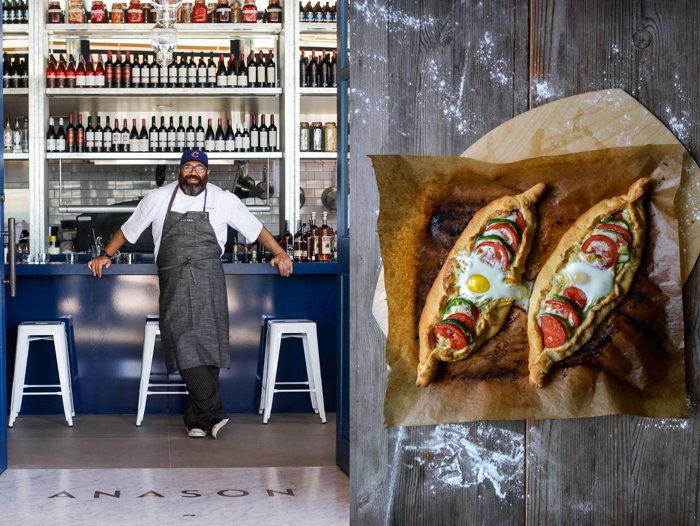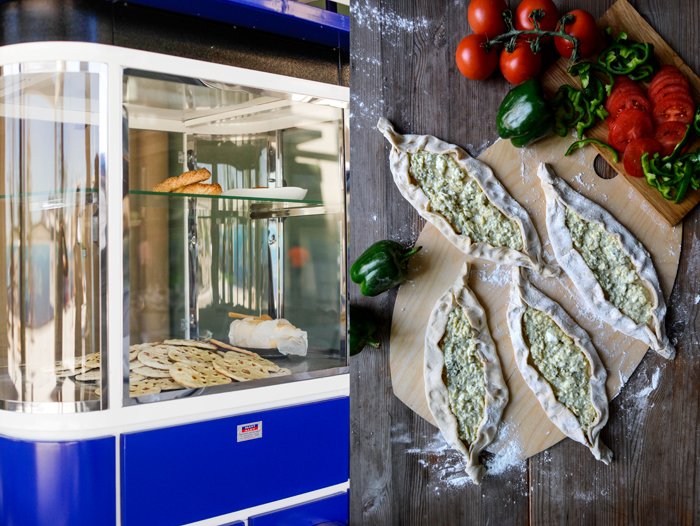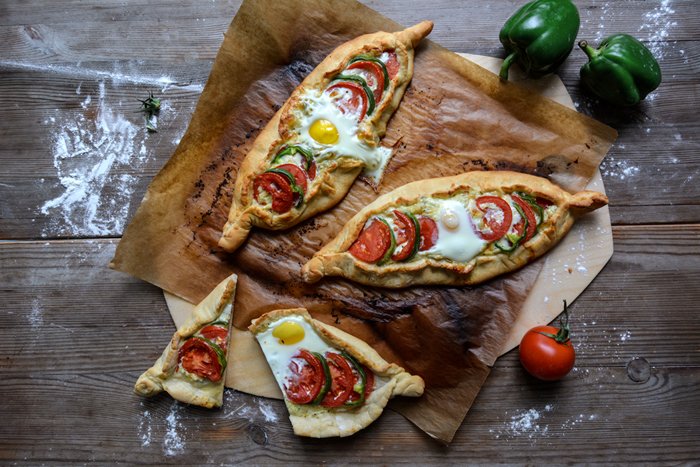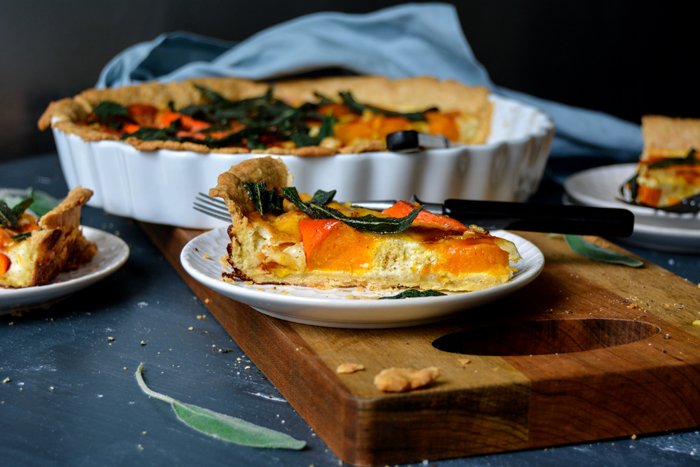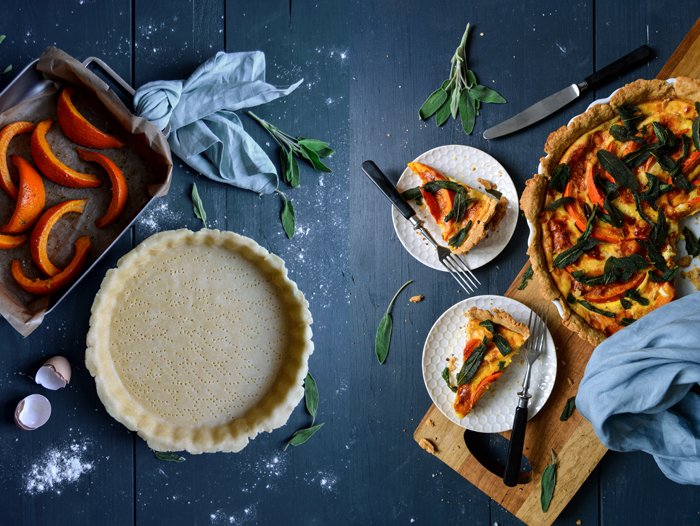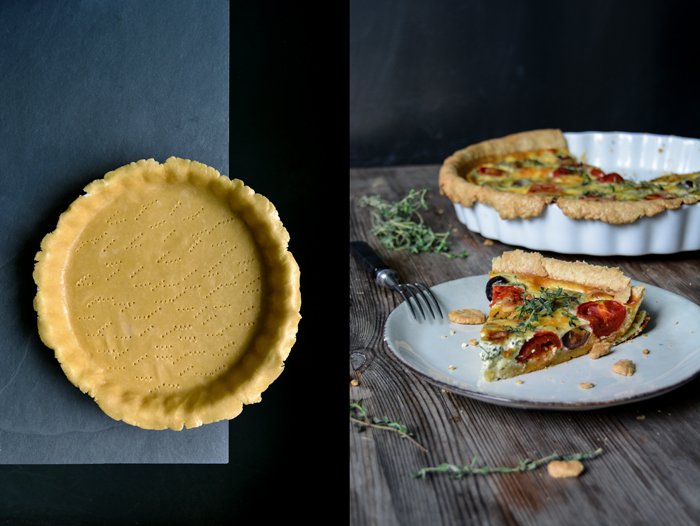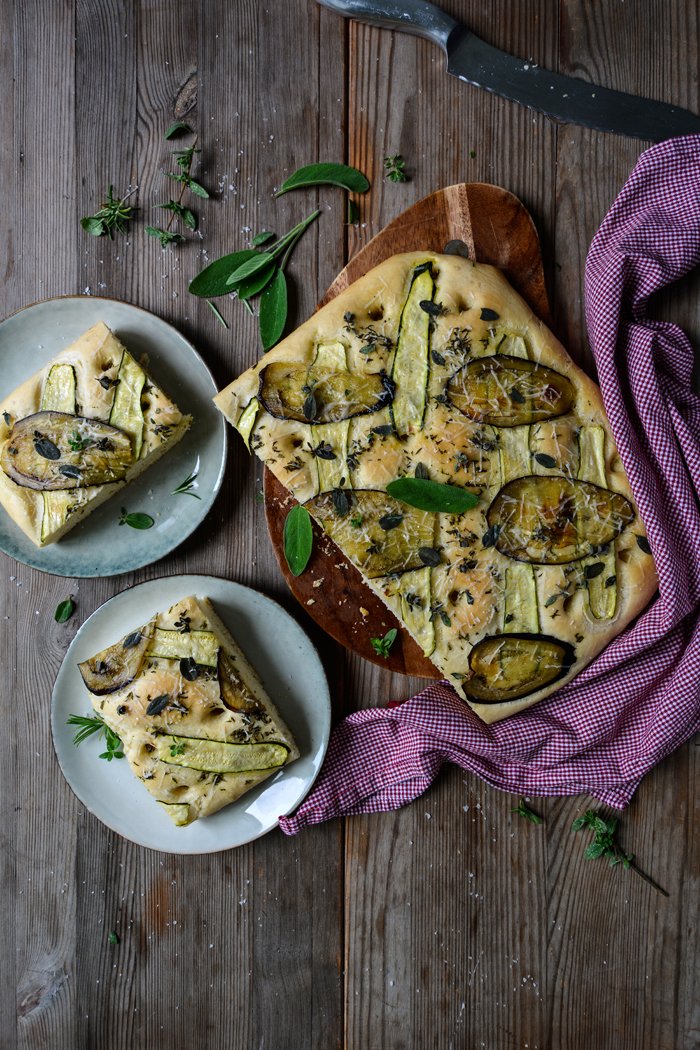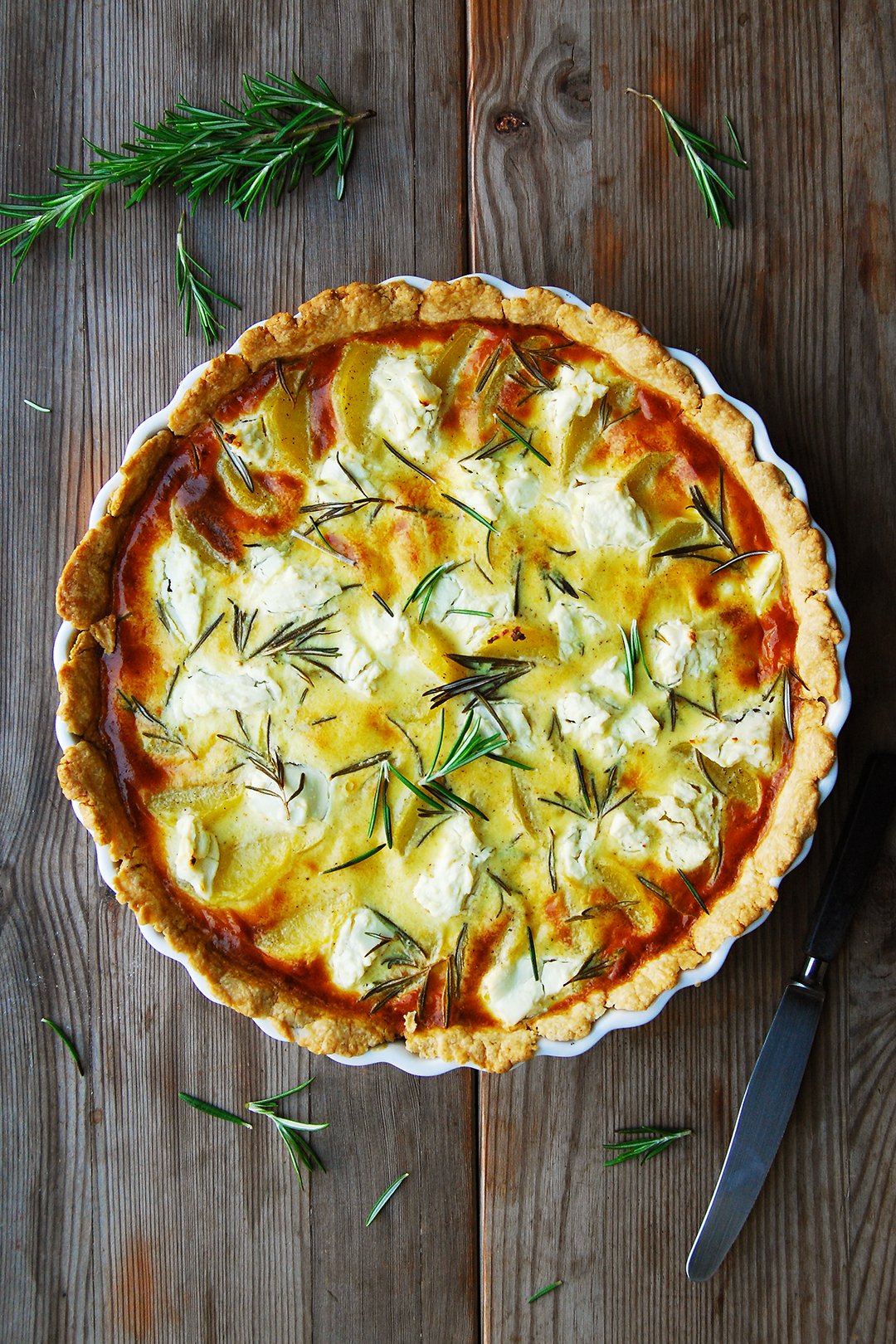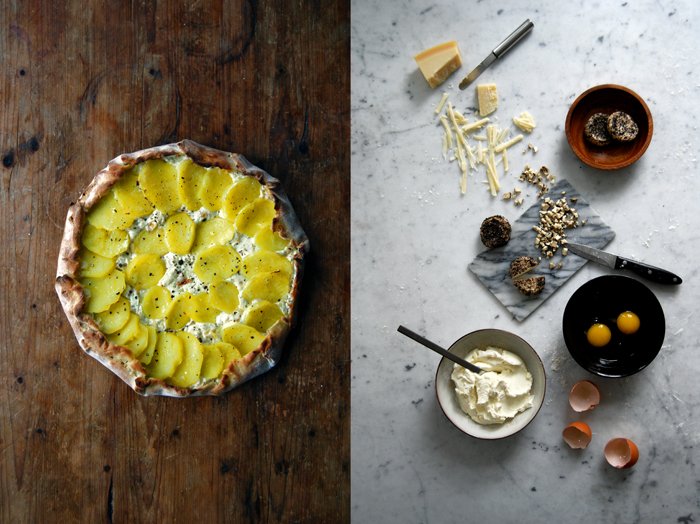LONDON
Food creates that safe, innocent space where we can meet without being a threat to each other; where we can be ourselves, embrace the fact that we are all unique through our unique stories, but when we exchange our stories - and the food connected to them - our paths converge and our lives intertwine.
To be able to share our stories, we must let go of our defenses, of our fear to be judged, condemned, or misunderstood by the ones who listen. We must accept our own vulnerability. The ground will feel wobbly, uncertain at times, but once we share our true story - and fully identify with that story - we transform; we get closer to our self and become stronger. When understanding is mutual, heartfelt on both sides, when we allow compassion, we have a real chance for change.
London was the last stop of my NOON book tour and the audience, our guests, made it easy for me to let go of my own defenses. It was an intimate evening at Hanna Geller’s (Building Feasts) beautiful, calm home. Helen Goh and I were in conversation and Hanna gently guided us through our lives, our books, our cooking and baking, and she made us feel safe to talk just as much about our confidence as about our insecurities. Sitting together with our guests in a circle, sharing food and champagne, and sharing our stories and thoughts about our lives and careers, but also sharing our vulnerability, brought all of us closer together.
Hanna opened more than just the doors to her home for the NOON book launch, without her help, trust, support, and friendship the evening wouldn’t have been possible. She prepared the food while I was running around London stock signing copies of my book, she bought champagne glasses when I noticed that I had forgotten to hire them. And the night before the event, I had the most peaceful dinner with her and three of her four boys. Sitting at her kitchen counter, a bowl of steaming soup in front of me, a dripping cheese sandwich in my hand, everyone chatting and laughing, made me feel so good, so calm, and ready for the London book launch.
And then, last Thursday night, we filled our glasses with Lallier Champagne’s glorious Grand Rosé Brut. Just like in Berlin, everyone fell in love with its fine fruity taste and delicate bubbles. Thanks to Aileen of Lallier UK, we even got a brief but very entertaining introduction to the champagne’s history and flavor profile. I can always enjoy a glass of champagne, any time, but it fit particularly well to the snacks from NOON that we - or rather Hanna - prepared and served to our guests: Peach Tart with Stilton (this is also the recipe that I’m sharing with you today, see below), Roasted Squash, Parsnip, and Grape Salad with Blue Cheese (click here for the recipe), and the Sauerkraut and Hummus on Sourdough Bread that already won the hearts of many NOON readers all over the world (here’s the recipe).
While I was in London, I got the chance to meet some book sellers at their independent bookstores to sign copies of NOON. There’s something magical about these places, the smell of books, the eyes of the customers concentrated and focussed while leafing through the pages of a book that, in that moment, becomes a world on its own. There’s a certain peace in these stores that soothes the mind and gives it some rest. That’s the magical power of a book.
Here’s a list of the London bookstores where you can find signed copies of NOON:
Books for Cooks (no signed copies but co-owner Eric Treuillé tests and serves dishes from the cookbooks at his Notting Hill bookstore / restaurant)
When you only have a few days in a city - for pleasure or business, it doesn’t really matter - when you’re on your feet constantly, it’s heavenly to come back to a hotel that feels as comfy as home but still so special that it excites and makes you smile every time you enter the loungy lobby.
The Hoxton Holborn managed to help keep my mood and energy level high and happy. Right in the center, the hotel sitting snug between Soho and Farringdon, I often didn’t even use the tube and just walked. My room was so quiet and cozy that I could have stayed for weeks (there’s something about British interiors, especially in bedrooms and bathrooms, that makes me forget about my usually quite minimalist approach to design and consider changing my entire Berlin flat from white walls to extravagantly patterned wallpapers).
Unfortunately, my schedule was tight and I didn’t get to indulge as wildly into lunches and dinners as I would have loved to, but here are some of the spots that I enjoyed while running around the city:
Quo Vadis, Smoked Eel Sandwich with a glass of crisp white wine, sitting outside on the bench (recommended by inspiring Gurdeep Loyal, author of Mother Tongue)
St. John’s Marylebone, Eccles Cake with Lancashire Cheese
Borough Market, Dorset oysters at Shellseekers (they also had the biggest oyster I’ve ever seen, 10 years old, but in the end I went for the smaller 3-year-old ones; they tasted fantastic, a little sweeter than my beloved French Fines de Claire)
Bishops Finger pub, traditional Fish & Chips
Ottolenghi Spitalfields (a tradition, for lunch)
The official NOON book tour came to an end and I want to thank YOU for following my journey that led to this book, and for your support of my work, of my recipes, and of this book that means so much to me. It’s at the same time scary and beautiful to see a book leave my kitchen and enter yours. So enjoy NOON, now it’s yours!
And I want to thank everyone who made the NOON book tour possible, in New York, in Berlin, and now in London:
Our curious guests, Hanna Geller and her son William, Helen Goh, the 3 ladies of Lallier UK: Aileen Rolfe, Rebekah Crabb, and Harriet Chandler, Champagne Lallier and Johannes Rohmer, Ingrid Meyer-Lohrmann and IML Kommunikation, everyone at The Hoxton Holborn, Eva Kaiser PR, Gianni Diliberto, Chronicle Books, and everyone at the Abrams&Chronicle Books UK headquarters.
So much love! Meike xxx
The photos taken at the NOON book launch in London are by Gianni Diliberto. The other pictures are by me.
Peach Tart with Stilton and Thyme
NOON: Simple Recipes for Scrumptious Midday Meals & More, Chronicle Books:
Bake your peach tart in the evening and take it with you to work the next day. At noon, go outside and sit down in a park, and when you munch on the first mouthful, close your eyes. Buttery pastry, chunky peaches, Stilton, and thyme, all in one bite, taste like a summer holiday memory turned into food. The sweet, fruity juices and salty cheese can almost compete with a blissful day at the beach.
NOTE: you can also replace the peaches with pears.
Serves 3 to 4
FOR THE PASTRY
2 cups (260 g) all-purpose flour
1 teaspoon fine sea salt
½ cup plus 1 tablespoon (130 g) unsalted butter, cold
1 large egg
FOR THE TOPPING
3 large white doughnut peaches, cut in half lengthwise
2 large yellow peaches, cut into quarters
2½ tablespoons olive oil
3 ounces (85 g) Stilton or Roquefort, crumbled
15 fresh small thyme sprigs, plus 1 tablespoon thyme leaves
Flaky sea salt
Coarsely ground pepper
For the pastry, combine the flour and salt in the bowl of a stand mixer fitted with the paddle attachment. Add the butter and use a knife to cut it into the flour until there are just small pieces left. Quickly rub the butter into the flour with your fingers until combined. Add the egg and mix on low just until the dough comes together. Form the dough into a thick disc, wrap it in plastic wrap, and freeze for 10 minutes.
Preheat the oven to 400°F (200°C).
On a work surface, place the dough between 2 sheets of plastic wrap and use a rolling pin to roll out into a disc, large enough to line the bottom and sides of a 10 to 12-inch (25.5 to 30 cm) quiche dish; a smaller quiche dish makes a thicker pastry base, which is nice for the peaches. Fit the dough into the quiche dish, pushing it into the dish, especially along the edges. Use a fork to prick the dough all over. Bake for about 15 minutes or until golden. If the dough bubbles up, push it down with a fork.
For the topping, arrange the peaches in circles on top of the prebaked pastry; for the middle of the tart, cut 2 yellow peach quarters in half again and arrange in a small circle. Drizzle with the olive oil, then sprinkle with the Stilton, thyme sprigs, and a little flaky sea salt. Bake for about 23 minutes or until the pastry is golden and crispy and the cheese is melted. Take the tart out of the oven, then immediately sprinkle with the thyme leaves and a little pepper. Let the tart cool for at least 15 minutes. Enjoy warm or cold.
NOON is OUT (and on Broadway)!
I just arrived in New York, happy and overwhelmed, on the publication day of this book that means so much to me.
Noon (and NOON) is a gift to yourself, shape that time of the day so that it fits to your own cravings. Make it yours! Use this 1 hour, or these 30 minutes, to make yourself feel good. We plan so much in our lives, every day, we just refuse to often do so when it comes to our own, our very personal needs. And we all need a break but we associate the creation of that break with even more work. So the solution is to find ways (recipes) to reduce that work and time for the preparation of our lunch so that we actually have more time for ourselves when we finally sit down; time to relax and enjoy. I hope NOON can offer you these recipes, but even more, I hope it offers you inspiration to make noon yours.
If you don’t have your copy yet, you can find all the links to order it online here, or support local and buy, or order the book from any bookstore all over world. The chapters in NOON cover Salads, Vegetables, Soups, Sandwiches, Pasta, Seafood, Meat, and Grains & Bakes - so your midday break will definitely be sorted!
Good noon! Meike xxx
The picture of me on Broadway was taken today - right after I had landed in New York - in front of Rizzoli Bookstore where I‘ll be in conversation with Hetty Lui McKinnon on Thursday, September 7th at 6pm - come join us! (For more information, click here)
If you won’t be in New York this week, but if you happen to be in London on October 5th, you can join my conversation with Helen Goh at Building Feasts, hosted by Hanna Geller, with Lallier Champagne and snacks from NOON! (For more information, click here)
Hamantashen with Lemon-Parsley Ricotta
Hamantashen are little pastry pockets, not more than a small bite, usually sweet and filled with poppy seeds, jam, or dried fruit. I turned them into a savory treat with a very lemony ricotta filling refined with lots of chopped parsley. It's a traditional Ashkenazi pastry, baked and shared during the Jewish holiday of Purim, starting this year on the evening of March 16th and ending 24 hours later. So why am I baking them? And why now?
My friend, the Berlin-based American baker Laurel Kratochvila of Fine Bagels spontaneously started Hamantashen for Ukraine, a show of worldwide bakery solidarity for the people of Ukraine. Profits of the sales are being donated to the Polish Humanitarian Action to help and support Ukrainian refugees at the Polish border. Laurel and her bakery friends will bake and sell hamantashen between now and March 17th, the 14th day of the Hebrew month of Adar. To find out where you can buy the charity pastries click here for the ever expanding list of participating bakeries all over the world.
Purim is celebrated to remember the saving of the Jewish people - thanks to queen Esther - from Haman, a vizier of the First Persian Empire who wanted to kill all Jews in the empire. Traditionally, food, drinks, and gifts are shared on this holiday, hamantashen are enjoyed together in the community, donations are given to the poor, and children and adults alike dress up in costumes. Maybe most importantly, these days there's often a reflection on modern day Hamans in the world. That's where this fundraiser comes in.
Laurel shared her recipe for sweet hamantashen with poppy seeds with me and I'll share my first attempt to bake hamantashen with you. Not sweet but packed with lemon-parsley ricotta.
Thank you, Laurel!
Hamantashen with Lemon-Parsley Ricotta
Makes 22 hamantashen
For the pastry
285g / 2 1/4 cups all-purpose flour
1 teaspoon fine sea salt
120g / 1/2 cup plus 1 teaspoon unsalted butter, cold
1 large egg
For the filling
125g / 4.5 ounces fresh ricotta, drained
1 large egg
30g / 1 ounce Parmesan, finely grated
1 small bunch fresh flat-leaf parsley, leaves only, finely chopped
1 scant tablespoon freshly grated lemon zest
1/4 to 1/2 teaspoon fine sea salt
Coarsely ground pepper
For the pastry, combine the flour and salt in the bowl of a stand mixer fitted with the paddle attachment. Add the butter and use a knife to cut it into the flour until there are just small pieces left. Quickly rub the butter into the flour with your fingers until combined. Add the egg and briefly mix with the paddle until crumbly. Form the dough into a thick disc, wrap it in plastic wrap, and chill in the fridge for 1 hour.
Preheat the oven to 180°C / 350°F (preferably convection setting). Line a baking sheet with parchment paper.
For the filling, whisk together the ricotta, egg, Parmesan, parsley, lemon zest, 1/4 teaspoon salt, and a generous amount of pepper in a medium bowl. Season to taste with additional salt.
On a work surface, place the dough between 2 sheets of plastic wrap and use a rolling pin to roll out until it’s about 3mm / 1/8 inch thick. Using a 7cm / 3 inch round cookie cutter, cut out circles, re-rolling any pastry scraps. Place 1 teaspoon of the filling in the middle of each circle. To shape, fold 3 sides inward to make a triangle, either overlapping or pinching where the edges meet. Transfer to a large platter and chill in the fridge for 10 minutes.
Transfer the hamantashen to the prepared baking sheet and bake for about 18 minutes or until the pastry is golden and just baked through. Let them cool for a few minutes and enjoy!
______________________________
Hamantashen with Poppy Seeds
by Laurel Kratochvila / Fine Bagels
Makes 40 hamantashen
For the pastry
440g / 3 1/3 cups all-purpose flour
240g / 1 cup plus 1 teaspoon unsalted butter, cold, cut into cubes
130g / 1 cup plus 1 tablespoon finely ground almonds
120g / 1 cup confectioners sugar
1/4 teaspoon fine sea salt
2 large egg, beaten
1 teaspoon vanilla extract
For the filling
150g / 1 1/2 cups ground poppy seeds
75g / 1/3 cup plus 1 tablespoon granulated sugar
210ml / 3/4 cup plus 3 tablespoons whole milk
2 teaspoons unsalted butter
1/2 lemon, juice only
2 tablespoons honey
For the pastry, in the bowl of a stand mixer fitted with the paddle attachment, mix the flour and butter on low speed until sandy in texture, no bits of butter remaining. Add the ground almonds and confectioners sugar and mix until well combined. Add the salt, eggs, and vanilla and mix on low until the dough has just come together and no dry bits remain. Press the dough into a thick disc, wrap it in plastic wrap, and chill in the fridge for 2 hours or up to 48 hours.
For the filling, in a heavy, medium saucepan, bring the poppy seeds, sugar, milk, butter, and lemon juice to a gentle boil over medium heat. Reduce the heat to low and simmer until thickened. Remove from the heat, stir in the honey, and let cool completely before using. Covered airtight, you can refrigerate it for up to 1 week.
Preheat the oven to 170°C / 340°F. Line a baking sheet with parchment paper.
To use the chilled pastry, you must break it: Fold it in half and roll it out once. It will crack. Fold the dough back up and roll out a second time. Now it's ready.
On a work surface, place the dough between 2 sheets of plastic wrap and use a rolling pin to roll out until it’s about 3mm / 1/8 inch thick. Using a 7cm / 3 inch round cookie cutter, cut out circles, re-rolling any pastry scraps. Place 1 teaspoon of the filling in the middle of each circle. To shape, fold 3 sides inward to make a triangle, either overlapping or pinching where the edges meet. Transfer to a large platter and chill in the fridge for 20 minutes.
Transfer the hamantashen to the prepared baking sheet and bake for about 15 minutes or until the pastry is golden and just baked through. Let them cool for a few minutes and enjoy!
Meet In Your Kitchen | Alfredo Sironi's Pizza with Cima di Rapa and Salsiccia
This post is part of my Meet in My Kitchen podcast: How did we get to where we are in life & what does food have to do with it
"Food means a lot, not everything, but a lot. I enjoy cooking more than eating." - Alfredo Sironi
There are two things Alfredo Sironi does all the time: chatting and eating while constantly moving around. When I sat with him outside his Sironi La Pizza restaurant in Berlin's Goltz Kiez, an endless flow of children, neighbors, staff, and guests stopped by to talk to the baker, always having his full attention. When we were at his Sironi il Pane di Milano bakery, at Kreuzberg's Markthalle Neun, he grabbed the pepper grinder from one of the stalls next to him, exchanging it for a piece of pizza and a quick chat with the chef. He nibbles bites of warm salsiccia from a tray while passing by and allows himself a couple minutes to indulge in the pizza bianca that we just baked together, but he won't sit still. Only quick moments of pleasure, before the man moves on to the next venture.
Alfredo says he's a better cook than eater. He blames his childhood. When you basically grow up right in a family restaurant you're always on the run, always looking out for problems that need to be solved and people who need to be taken care of. You have a quick nibble in between chats but you barely sit down to eat. It runs through his family, he says.
"Everything we describe as tradition is fake. There weren’t potatoes in Germany, there weren’t tomatoes in Italy. Noodles, pasta come from China. It’s a cultural process, every day rewritten over and over again." - Alfredo Sironi
Growing up on a farm in Lombardy - between Milan and Como, close to northern Italy's buzzing industrial center yet at the same time, you're surrounded by lush green fields, paddocks, and horses - his life was about his parent's restaurant, his family and friends, and the restaurant's regular guests. Women always played an important role in his world. Although his father started the business, and he's also the most passionate cook in the family, it was Alfredo's mother who kept the motor running smoothly. Due to the region's economic success, the women in northern Italy already ran thriving businesses in the 50s. The cliché of the mother, cooking and staying at home in the kitchen, wasn't Alfredo's reality.
The Sironi family comes from Piedmont, Lombardy, Veneto, and Emilia-Romagna so the family's home cooking mirrors the best of what the four regions bring to the table. Bread and pasta is a staple, always homemade and part of every day's lunch and dinner. Everyone knows how to make it, it's in their blood. And exactly this would become one of Alfredo's greatest assets.
"You can’t prepare yourself for your failure but you have to be prepared for your success. When you start a business, you only focus on avoiding that it crashes. You hope that customers will come, that you can pay your bills, and that it will all work out. But in reality, everything can be totally different, that you are successful. And then the bakery was too small, I hadn’t considered this option in the beginning." - Alfredo Sironi
Until Alfredo moved to Berlin at the age of thirty, he never questioned his cosmos circling around the food and the people that were simply there all his life. It could have been so easy for him to just stay there, to take over the family business at one point, to live this beautiful life in this beautiful place with all the people he loves - but he was hungry for something else. So when Alfredo came up north to move to Germany's capital, he used his memories of the people and the food in Italy, the memories of his daily life, to found his own bakery. Although he studied history in Milan and already saw himself following an academic career, things changed.
In 2010, Berlin's food scene was buzzing and hungry for the new. Carbs are Alfredo's passion. Every day, bread was freshly baked and pasta freshly rolled at his family's restaurant and he helped out whenever a hand was needed. For him, good bread isn't science, it's knowledge and experience. He knew Berlin didn't have anything like the Milan-style bread he grew up with and felt the city would love it yet he was also aware of the risks.
In the end, there was nothing to worry about. It only took a few months for the Berliners to fall in love with the baker and his goods. Right from the start, you could always find Signor Sironi on the annual Berlin's Best Bread lists. His sourdough loaves are praised, his sheet-pan pizza is the reason for ongoing pilgrimages of the carb loving crowds to his bakery in Kreuzberg and to his new pizzeria where the pizza is round. Alfredo Sironi knows his dough, maybe it's as simple as that.
Alfredo shared the recipe for his Pizza Bianca with Cima di Rapa and Salsiccia with me. It's a recipe that I love so much that when I first ate it a few years ago, I came up with my own take on it for the blog. It proves that reducing the toppings for pizza often leads to the best results.
The podcast episode with Alfredo Sironi is in German. You can listen to the Meet in My Kitchen podcast on all common podcast platforms; there are English and German episodes. You can find all the blog posts about these podcast episodes including my guests’ recipes here on the blog under Meet in Your Kitchen.
Listen to the podcast episode with Alfredo on:
Spotify / Apple / Deezer / Google / Amazon / Podimo
On Instagram you can follow the podcast @meetinmykitchenpodcast!
Pizza Bianca with Cima di Rapa and Salsiccia
by Alfredo Sironi
Makes 2 to 3 pizza sheets (using 30 x 40cm / 12 x 16“ baking sheets; if you make 3 sheets the pizza base will be thinner and crunchier, 2 sheets will lead to a thicker, softer base)
For the dough
700ml / 3 cups water, lukewarm, plus more as needed
10g / 1/3 ounce fresh yeast, crumbled
1kg / 7 2/3 cups high gluten wheat flour (German flour type 1050)
20g / 1 tablespoon barley malt syrup (or rice syrup, or molasses)
20g / 4 teaspoons fine sea salt
For the topping
4 - 6 salsiccie (or any other coarse sausage), skin removed, sausage torn into bite size pieces
800g - 1.2kg / 1 3/4 pounds - 2 2/3 pounds cime di rapa, blanched or sautéed (you can also use drained jarred cime di rapa or replace it with broccoli)
500 - 750g / 1 - 1 2/3 pounds drained mozzarella, cut into french fries-shapes
Olive oil
Freshly ground black pepper
In the large bowl of a stand mixer, fitted with the hook attachment, whisk together the water and yeast and let it sit for a minute. Add the flour, syrup, and salt and knead well for about 5 minutes or until smooth; add more water if the dough is too firm. Cover the bowl and let the dough sit for 10 minutes (the ideal ambient temperature is 26-30°C / 80-86°F; you can use the oven or place the bowl on a heater).
After 10 minutes, leaving the dough in the bowl, grab the dough from underneath and fold it on top of itself then turn the bowl by 90° and repeat folding and turning the bowl for 4-5 times. Let the dough sit for 15 minutes then repeat the same procedure once again. Cover the bowl with plastic wrap, or put it in a rubbish bag and close it; you can also use a container with a tight fitting lid. Keep the dough in the fridge for 18-24 hours.
After 18-24 hours, divide the dough in 2 or 3 portions, roll out each portion so that it’s roughly the size of your baking sheet then oil 2-3 baking sheets and arrange the prepared dough on top and cover with kitchen towels. In a warm place, let the dough rise until it roughly doubles in size; depending on the ambient temperature, this will take 30-60 minutes.
Preheat the oven to the highest temperature setting (at least 250°C / 480°F).
Divide the salsiccia, cime di rapa, and mozzarella among the prepared baking sheets and bake for about 10-13 minutes or until golden brown and crunchy. Drizzle with a little olive oil, sprinkle with some pepper, and enjoy immediately!
Berlin & 365's Autumn Quiche with Squash, Taleggio & Sage
My editor at Prestel in New York asked me one day where I'd like to launch my new book. Berlin, I said, and Malta, of course, and London, and NYC, and the West coast this time, LA and San Francisco. It's nice to dream and imagine all these places on both sides of the Atlantic, to think of all the people I'd meet and who'd celebrate 365 together with me. I'm good at dreaming but I'm bad at not following a dream. It makes me restless, once my mind is set on something it doesn't want to stop until it gets there. Sometimes my dreams don't work out, sometimes they do - even though everybody around me has given up hope. And sometimes they happen to be even better than I hoped they'd be.
There are many ways to launch a book, but I wanted a feast - in six cities. There are many reasons why a dream works out, luck (always), persistence (tiring for everyone around), thoughtful planning (I studied architecture, I'm good at that), and help and support from others (and I got a lot of that). In the next couple months I'll share some impressions of the six 365 book launch events here on the blog, I'll write about the places and what I love so much about them, and about the people who made all this possible. And to give you a little taste of this book tour, I'll always share one of the recipes that we enjoyed at the events. So I'll start with Berlin, my home, the place where my adventurous journey began, and with the recipe for the Squash and Taleggio Quiche with Crispy Sage (you can find it in the book, recipe no. 287, and below). This quiche became the cover of 365 and quickly gained fans and fame all around the globe.
On the morning of September 23rd I started to feel nervous, it was the publication day of the German 365 and the day on which I'd step out of my comfort zone and talk about the book that I'd been working on for so many days and nights. It feels good when a book is out, you can't change anything anymore and at one point you even stop dreaming about gram-to-cup conversions but it's also the time when people start seeing what you've created, when it's not just you and the book anymore. It's scary.
So I kept myself busy during the day (the best strategy to calm my antsy mind), I went to the hair dresser (thank you Jay for dealing with my anxious self) and then drove straight to the Hotel de Rome, a former bank turned into the hotel of your dreams where 365 would soon see the most marvelous of celebrations. Türkan Arikan, the hotel's Director of Communications and the best event partner an author could ask for, had reserved the stunning roof terrace for our launch - my favourite spot for a summery sundowner - but Berlin's weather was set on drizzle, wind, and grey, no blue skies and golden sunset. We took over Hotel de Rome's imposing Opera Court with our 100 guests instead, nibbled on hearty tastings from 365 prepared by the diligent kitchen crew, and on the bittersweet recipe no. 70 from 365, Tangerine Jam Chocolate Brownies baked by Fine Bagels' fabulous Laurel Kratochvila. A fair feast needs wine and we happily filled our glasses with the wonderful reds, whites, and rosé from Meridiana Wine Estate in Malta (thank you Karl Chetcuti for making Maltese wine that fills my heart and every room on the book tour with so much joy). Florian Domberger baked and shared Berlin's best bread with us, his crunchy, spongy Beutebrot. And I had a very honest, intimate talk about the book with my friend Cynthia Barcomi. This woman manages to fit more into one life than anyone else and her laugh is so charming and infectious that you totally forget that you're nervous and that you're talking about something that existed, not too long ago, only in your head before it became a book. Could I ask for more? No, it was a feast.
Thank YOU so much for all the love and support that you've already shown for 365! If you have a few minutes and you're in the mood, it would be great if you could write a review for the book on Amazon (here are the links for the US, UK, Germany).
You can see all the pictures of the Berlin book launch event here on Facebook. And if you cook or bake recipes from the book and share pictures on Instagram, you can add #365TheCookbook so that they show up in the book's collection. If you feel like diving into the love that this book received so far, you can read about it here.
Squash and Taleggio Quiche with Crispy Sage
from '365 - A Year of Everyday Cooking & Baking' (Prestel, 2019)
Serves 4 to 8
For the filling
1 1/3 pounds (600 g) seeded squash, preferably peeled butternut or Hokkaido with skin, cut into 1-inch (2.5 cm) wedges
1 tbsp olive oil
Flaky sea salt
Finely ground pepper
3 large eggs
3/4 cup (175 g) sour cream (or crème fraîche)
1/2 cup (120 ml) heavy cream
1 tsp fine sea salt
Nutmeg, preferably freshly grated
5 ounces (140 g) mild, sweet cheese that melts well, such as Taleggio, fontina, or Robiola, diced
3 tbsp (45 g) unsalted butter
50 large fresh sage leaves
For the pastry
2 cups (260 g) all-purpose flour
1 tsp fine sea salt
1/2 cup plus 1 tbsp (130 g) unsalted butter, cold
1 large egg
Preheat the oven to 400°F (200°C).
For the filling, spread the squash in a large baking dish, drizzle withthe olive oil, and toss to combine. Season to taste with flaky sea salt andpepper and roast for 15 minutes then flip the squash and continue roasting for10 to 15 minutes or until golden and tender; set aside.
For the pastry, combine the flour and fine sea salt in the bowl of astand mixer fitted with the dough hook attachment. Add the butter and use aknife to cut it into the flour until there are just small pieces left. Quicklyrub the butter into the flour with your fingers until combined. Add the egg andmix with the hook until crumbly. Form the dough into a thick disc, wrap it inplastic wrap, and freeze for 10 minutes.
On a work surface, place the dough between 2 sheets of plastic wrap anduse a rolling pin to roll out into a disc, large enough to line the bottom andsides of a 12-inch (30 cm) quiche dish. Fit the dough into the quiche dish,pushing it into the dish, especially along the edges. Let the dough hang overthe rim a little or trim with a knife. Use a fork to prick the dough all over.Bake for 15 minutes or until golden. If the dough bubbles up, push it down witha fork. Take the quiche dish out of the oven and reduce the heat to 350°F (180°C).
In a medium bowl, whisk together the eggs, sour cream, heavy cream, andfine sea salt and season to taste with pepper and a generous amount of nutmeg.
Arrange the squash in a circle on top of the pre-baked pastry andsprinkle with the cheese. Pour the egg mixture over the squash and bake for 45to 55 minutes or until golden brown and firm. Take the quiche out of the ovenand let it sit at least 10 minutes.
In a large saucepan, heat the butter over medium-high heat, add thesage, and cook, stirring gently, for 20 to 30 seconds or until golden, green,and crispy—mind that the leaves don’t burn. Spread the sage on top of thequiche, sprinkle with a little pepper, and serve warm or cold.
16 Recipes for your Easter Brunch Table
Hunting Easter eggs in the woods was one of my childhood's spring highlights. The sweet smell of blossoms and sunlight in the air, the trees' leaves presenting their most fragile green, and - in a lucky year - I could even replace boots and jacket for shirt and jeans while searching for golden wrapped chocolate eggs and bunnies. I always loved the sprouting energy that comes with the change of season, when winter's shades of grey and brown give way to vibrant colours. Easter is a changing point in the year, there's the promise of summer in the air.
Is there a better way to celebrate this day than gathering your loved ones around the table and treating them to a luscious brunch? Here's some inspiration (click the titles for the recipes) - and there will be two new Easter recipes coming up this Sunday and next Wednesday!
Happy Easter!
Tsoureki – Greek Easter Bread with Aniseed and Orange Blossom Water
Gruyère and Red Onion Focaccia
We spent our Christmas in the Mediterranean, a premier for me, we normally stay in the cold North. I decorate our tree and the rest of the apartment according to my annual passion for wintery kitsch, and I eat duck, German potato dumplings, and usually (always) too many cookies. 2016 was different, we decided to go to Sicily first and spend a few relaxing days in the heart of the Archaeological Park of Agrigento (I'll share my impressions with you next week). Malta was next on our itinerary, and with it came along lots of sunshine, rough seas, long walks in the countryside, and my wonderful, crazy Maltese family. It was loud and silly, we ate and drank too much wine in front of my Maltese Mama's gorgeous crib in Msida, and I was happy.
I learned that a proper crib is an important part of the Maltese celebration, and I'm talking about cribs of rather large dimensions, well equipped with colourful figures, various animals, a real stable setting made of rocks, and most importantly, an impressive light installation to represent the firmament. Every house leaves the main door open, so that passersby can peak through the glass door to admire the re-enacted scenes of Jesus' birth. I've seen impressive installations that leave no doubt that the Maltese take Christmas very seriously.
Being under the hot Mediterranean sun in the coldest season of the year has many advantages, my vitamin D resources are definitely recharged. Everything is fine as long as you stay outside the house, inside it's freezing cold. A country where the temperature barely drops below 16°C (60°F) doesn't really have to think about those few days of sharp chill. But a person who's used to central heating - me - has to get used to the fact that the bedroom (and the bathroom!) can actually feel much colder than the air outside. I coped and complained, but our sunny walks along the lush green Dingli cliffs definitely made up for it.
And I'll never forget our New Year's Eve in Gozo, we stayed at a beautiful farmhouse at the border of the village of Qala. We had a gorgeous room, with a large terrace and the most stunning views of the islands of Comino and Malta. We ordered 3 (!) pizzas from the local Maxokk bakery, bought a bottle of local red wine from my friends at Meridiana, and just sat on the sofa, amazed by the peace in front of our eyes.
I had never seen Malta like this, so green and in full bloom. My past travels covered everything from March to October, but I always avoided the winter months. I'd love to show you pictures, but I was on a mission, I didn't touch my camera, I stayed offline most of the time, and I slowed down my pace drastically. So there are no pictures, but lots of beautiful memories of time spent in nature, silent, without any disturbing technical devices.
However, when we came back to Berlin, I noticed a slight feeling of dissatisfaction, I missed my Christmas. To make up for my nostalgic longings, I decided to have a Christmas week in January. In the past few days, I baked Christmas cookies and my boyfriend had to listen to me singing along to Christmas carols. My celebrations found their festive peak in a Christmas dinner for two with slow roasted duck (I used the recipe from my book), red cabbage with spices and apples, and German potato dumplings. Now I'm cured and we can move on with our lives - also in the kitchen.
My latest post-Christmas kitchen project led to a hearty yet airy focaccia, topped with thickly sliced red onions roasted on top of the dough in lots of olive oil and a generous amount of aromatic Swiss Gruyère cheese. It's pure comfort food. I cut a thick slice off the warm bread and enjoyed it on a chair that I placed close to the heater. I doubt I ever appreciated central heating as much as I do now.
If you're looking for some more focaccia inspiration, take a look at these recipes:
Gruyère and Red Onion Focaccia
Makes a 25 x 32cm / 10 x 12 1/2″ focaccia
For the dough
plain flour 500g / 3 3/4 cups plus 2 tablespoons
fast-acting yeast 1 (7g / 1/4 ounce) envelope
fine sea salt 1 teaspoon
granulated sugar 1 heaping teaspoon
water, lukewarm, 260ml / 1 cup and 2 tablespoons
olive oil 120ml / 1/2 cup, plus 1-2 tablespoons to oil the baking sheet
For the topping
Swiss Gruyère cheese, or any aromatic hard cheese, coarsely grated, 100g / 7 ounces
red onions, thickly sliced, 2
flaky sea salt
black peppercorns, crushed in a mortar
For the dough, combine the flour, yeast, salt, and sugar in the bowl of a stand mixer fitted with the dough hook. Add the lukewarm water and half the olive oil (60ml / 1/4 cup) and knead on medium-high speed for a few minutes until well combined. I mix it on ‘4’ on my KitchenAid. If the dough is too sticky, add more flour. Transfer the dough to a table or countertop and continue kneading and punching it down with your hands for about 4 minutes or until you have a smooth and elastic ball of dough. Place the dough back in the mixer bowl, cover with a tea towel, and let rise in a warm place, or preferably in a 35°C / 100°F warm oven (conventional setting), for about 60 minutes or until doubled in size.
Oil a 25 x 32cm / 10 x 12 1/2″ baking sheet.
When the dough has doubled in size, punch it down, take it out of the bowl, and knead for 1 minute. Using your hands, stretch and spread the dough on the oiled baking sheet. Cover with a tea towel and let rise in a warm place for about 20 minutes or until puffy.
Preheat the oven to 220°C / 425°F (convection setting).
Using the round bottom of a wooden spoon or your finger, punch around 6 x 7 holes into the surface of the dough. Arrange the sliced onions on top of the dough, pushing the slices gently into the dough. Pour the remaining olive oil over the dough and onion and into the holes. Sprinkle with the cheese and a little flaky sea salt and bake for 20 minutes or until golden and light brown. Sprinkle with crushed pepper and enjoy warm or cold. The focaccia tastes best on the first day.
Pear and Blue Cheese Tart from my cookbook and a picnic in Valletta
Malta, October 2016:
The sky was blue and October's sun still hot, it was a glorious Saturday morning when I met my friends in Msida. The air was filled with the usual chatting and laughing before we hopped into our cars to drive up to Valletta. We brought along the obligatory guitar and our picnic baskets packed with sandwiches, fruits, and a buttery pear and Stilton tart sprinkled with rosemary - a popular recipe from my Eat In My Kitchen book. And off we went to Malta's capital.
We had planned this day trip weeks in advance: to have a picnic in Valletta, high up on the bastions opposite The Three Cities, to park Michelangelo's beautiful Volkswagen beetle in the shade of one of the old olive trees, and set up a little table right next to this cute blue beauty on wheels. It was a luscious brunch in the most stunning surroundings and to bake a savory tart was the best choice for this occasion. You can prepare it in advance, it's delicious even when it's cold, and it fits perfectly to chilled sparkling wine. The topping is minimal, but the combination of baked pear, melted Stilton, and roasted rosemary is so good that it became one of my favorite recipes this year. The creation almost didn't make it into my book. I had a different tart in mind but I couldn't find a certain vegetable on the day of the shoot and spontaneously decided that I could also just fill the pastry with fruit, cheese, and herbs. It was a wise choice that I don't regret.
The setting was as spectacular as our nibbles. If you ever visit Valletta, you have to go to the St. Barbara Bastion and enjoy the breathtaking view overlooking the Grand Harbour and The Three Cities, Vittoriosa, Cospicua and Senglea. Then walk down to the Valletta Waterfront and take one of the little ferries to Cospicua. It only takes a few minutes and it allows you to enjoy two of the most stunning places in Malta, on land and from the sea: the golden beauty Valletta and the three fortified cities.
Pear and Blue Cheese Tart with Rosemary
From my first cookbook, Eat In My Kitchen
Serves 4 to 8
For the pastry
2 cups (260 g) all-purpose flour
1 teaspoon fine sea salt
½ cup plus 1 tablespoon (130 g) unsalted butter, cold
1 large egg
For the topping
2 large, firm pears, cut into thin wedges
3 ounces (85 g) aromatic blue cheese, such as Stilton, Roquefort, Fourme d'Ambert or Gorgonzola, crumbled
3 medium sprigs fresh rosemary, needles only
3 tablespoons olive oil
Flaky sea salt
A few black peppercorns, crushed with a mortar and pestle
For the pastry, combine the flour and salt in a large bowl. Add the butter and use a knife to cut it into the flour until there are just small pieces left. Quickly rub the butter into the flour with your fingers until combined. Add the egg and mix with the dough hooks of an electric mixer until crumbly. Form the dough into a thick disc, wrap it in plastic wrap, and freeze for 10 minutes.
Preheat the oven to 400°F (200°C).
On a table or countertop, place the dough between 2 sheets of plastic wrap and use a rolling pin to roll out into a disc, large enough to line the bottom and sides of a 12-inch (30 cm) quiche dish. Fit the dough into the quiche dish, pushing it into the dish, especially along the edges. Let the dough hang over the rim a little or cut it off with a knife. Use a fork to prick the dough all over. Bake for 15 to 18 minutes or until golden. If the dough bubbles up, push it down with a fork. (If you blind bake the pastry under parchment paper and dried legumes, remove the paper and legumes after 15 minutes and bake uncovered for a few more minutes until golden.)
Arrange the pear wedges in overlapping circles on top of the warm, pre-baked pastry, sprinkle with the cheese and most of the rosemary, drizzle with the olive oil, and season to taste with flaky sea salt and crushed peppercorns. Bake for 15 minutes or until the cheese has melted and the pastry is crisp. Sprinkle with the remaining rosemary and enjoy warm or cold.
10 Pumpkin recipes to inspire your Thanksgiving table
Thanksgiving calls for pumpkin on the table, lots of pumpkin! Since winter squash is so versatile, I wouldn't mind having a festive meal dedicated to these gorgeous beauties in orange, green, and golden yellow. Nibbles, soup, main, and dessert - I'd be up for a pumpkin celebration.
When it comes to the main course, we have two options, we can either go vegetarian and in this case I strongly recommend the Pumpkin Crespelle with Ricotta and Sage - although the Pumpkin Gnocchi wouldn't be a bad choice either. However, if you need some meat on your plate, I'll share my suggestions with you tomorrow. But we can already start thinking about the sides and there's a universe of options. Gnocchi always work, there's no doubt that their spongy softness is perfect to soak up the juices of a roast, or you can go for maple orange pumpkin with sage and walnuts from my tartine recipe below (without the bread); pumpkin, stilton, and rosemary is also a very pleasant combination (taken from another sandwich recipe below). Roast it, cook it, sauté the squash - thinly sliced - in a pan (like in the Hokkaido Pumpkin Spaghetti), or bake a soufflé. If you want to keep the crowd entertained while you're cooking, serve the Pumpkin Pesto, Date, and Chèvre Sandwich and everybody will be happy.
Click on the titles for the recipes
meet in your kitchen | Emiko Davies' Grape Focaccia & her life in Tuscany
Our long wooden dining table has seen many luscious lunches and dinners. It has its scars and scratches and I'm sure that a few of them came from an unexpected meal with friends a few months ago. It must have been spring, I was still busy proof reading my book and I was rather stressed. What was supposed to be a one hour snack with a friend from Malta turned into a little Friday feast, with three friends, salads, cheese, and salami, and with a few more bottles of white wine than one should open (and empty) on a Friday afternoon - but who cares, we had a wonderful time. We laughed so much that I managed to relax and forget my duties for a few hours - and it was the start of this meet in your kitchen feature.
One of the friends who sat at my table that day was my dear Heilala. Whenever we meet, we get lost in long conversations. Between nibbles of cheese and sips of wine, she told me about a friend from her school days who just published her first cookbook and had also gone through all the excitement that comes with the adventure of being a book author. Her friend lives in the heart of Tuscany, in Florence, once the breeding ground of breathtaking Renaissance art and architecture. If you've seen it once, you'll never forget its magical beauty. So Heilala told me that her friend lives right there, in this Italian paradise with her Italian husband and their little daughter, she writes a food blog and as I found out later, she's already at work on her second cookbook - she's called Emiko Davies.
I knew Emiko, not personally, but I've been a huge fan of her work for quite a while. Her recipes, her writing, and her photography have depth, every single aspect of her work shows that she's knows what she's talking about. Every picture she shares speaks of the beauty that surrounds her. If you live in a place that's so full of history, culture, and evolving traditions, where the fine arts have flourished for centuries, you can only grow. The former art and history student dug deep into Florence's culinary traditions. Like a scientist, she observed, read, and learned about the original cooking and baking of this part of Tuscany, a region that's so versatile and rich. Florentine, The True Cuisine of Florenceis a declaration of love, of someone who has experienced the city from the outside and has now become a part of it.
The curiosity and persistency of this food loving woman fascinated me - even more so after I found out that we share a beloved friend. We only got in touch last week, but I immediately knew that I wanted to meet Emiko in her kitchen. For know it's just a virtual meeting, but I'm planning to visit her next year, in real life - to be continued.
All pictures in this post are taken by Emiko Davies.
Schiacciata all'uva | Grape focaccia
from 'Florentine: The True Cuisine of Florence' by Emiko Davies, published by Hardie Grant Books
For one or two fleeting months of the year from September to October, the appearance of schiacciata all'uva in Florence's bakery shop windows is a sign that summer is over and the days will begin to get noticeably shorter. This sticky, sweet focaccia-like bread, full of bright, bursting grapes, is a hint that winemakers are working hard at that moment harvesting their grapes and pressing them.
These days, it is usually made with fragrant, berry-like concord grapes (uva fragola) or the more traditional sangiovese or canaiolo wine grapes. These grapes stain the bread purple and lend it its juicy texture and sweet but slightly tart flavour. They are also what give the bread a bit of crunch, as traditionally the seeds are left in and eaten along with the bread. Avoid using red or white seedless table grapes or white grapes for this – they just don’t do it justice in terms of flavour or appearance. If you can’t get concord grapes or it’s the wrong season, try replacing them with blueberries. It’s completely unorthodox, of course, but it’s a very good substitute, giving you a much closer result than using regular table grapes.
Makes 1 large schiacciata, serves 6–8
500 g (1 lb 2 oz) plain (all-purpose) flour, plus extra for dusting
20 g (3/4 oz) fresh yeast, or 7 g (1/4 oz/2 1/2 level teaspoons) active dry yeast
400 ml (131/2 fl oz) lukewarm water
75 ml (21/2 fl oz) extra-virgin olive oil, plus extra for greasing
600 g (1 lb 5 oz) concord grapes (or other black grape)
80 g (23/4 oz) caster (superfine) sugar
1 teaspoon aniseed (optional)
icing (confectioners’) sugar (optional)
Preparing the dough
This can be done the night before you need to bake it, or a couple of hours ahead of time.
Sift the flour into a large bowl and create a well in the centre.
Dissolve the yeast in some (about 1/2 cup or 125 ml) of the lukewarm water.
Add the yeast mixture to the centre of the flour and mix with your hand or a wooden spoon. Add the rest of the water little by little, working the dough well after each addition to allow the flour to absorb all the water.
Add 1 tablespoon of extra-virgin olive oil to the dough and combine.
This is quite a wet, sticky dough. Rather than knead, you may need to work it with a wooden spoon or with well-oiled hands for a few minutes until it is smooth. Cover the bowl of dough well with some plastic wrap and set it in a warm place away from draughts until it doubles in size, about 1 hour. If doing this the night before, leave the dough in the bowl to rise in the fridge overnight.
Assembling the schiacciata
Separate the grapes from the stem, then rinse and pat dry. There’s no need to deseed them if making this the traditional way.
Preheat the oven to 190°C (375°F).
Grease a 20 cm (8 in) x 30 cm (12 in) baking tin or a round pizza tray with olive oil. With well-oiled (or wet) hands, divide the dough into two halves, one slightly larger than the other. Place the larger half onto the greased pan and with your fingers, spread out the dough evenly to cover the pan or so that it is no more than 1.5 cm (1/2 in) thick.
Place about two-thirds of the grapes onto the first dough layer and sprinkle over half of the sugar, followed by about 30 ml (1 fl oz) of olive oil and 1/2 teaspoon of aniseed.
Stretch out the rest of the dough to roughly the size of the pan and cover the grapes with this second layer of dough, stretching to cover the surface. Roll up the edges of the bottom layer of dough from underneath to the top, to seal the edges of the schiacciata. Gently push down on the surface of the dough to create little dimples all over. Cover the top with the rest of the grapes and evenly sprinkle over the remaining aniseed, sugar and olive oil.
Bake for about 30 minutes or until the dough becomes golden and crunchy on top and the grapes are oozing and cooked.
Remove from the heat and allow to cool completely. Cut into squares and enjoy eaten with your hands. If you like, dust with icing (confectioners’) sugar just before serving – although this isn't exactly traditional, it is rather nice.
This is best served and eaten the day of baking, or at the most the next day.
You've lived in many countries and experienced a variety of cultures in your life, your mother is Japanese, your father is Australian, your husband is Italian and you grew up in Beijing. How has your diverse cultural identity influenced your life and cooking?
Moving around a lot and identifying with different cultures, I grew up not feeling like I was particularly attached to just one place. I think this made it very easy (perhaps even necessary – at least that's how I felt about it when I was 20!) for me to pick up a suitcase, buy a plane ticket and move to a new country to learn a new language and discover the new culture. I am also pretty sure this travel and experience partly contributed to me being an adventurous eater – always willing to try anything once. From the beginning, I understood that food is a way to connect with and understand a new culture – if, for Florentines, their number one beloved comfort dish is a warm panino made with the fourth stomach of the cow (it's known as a panino al lampredotto), then you can be sure it's one of the first things I tried – and fell in love with too!
What do you love the most about Florence? Do you find anything difficult to connect with?
There are many sides to Florence and the longer I live here, the more I discover another aspect! When I first moved here, it was so easy to fall head of heels for Florence – especially for someone who studied art and art history as I did! Everywhere you look, the place is touched with the Renaissance and the most important artists in history, it's like one giant museum. That's what drew me in. And it's what drew a lot of expats to Florence, so there is a large expat community with many similar-minded people, who are all here for similar reasons (love, food or art, usually!). I made friends easily here and felt really at home, ironically (as I always feel more at home amongst expats). But having said that, I find it's really difficult to make friends, really good friends, with Florentines. That's been a struggle. I ended up meeting and marrying one, but I have to say, he's quite different from the typical Florentine man!
Was it easy to become a part of the Florentine way of life?
I think yes and no. Living it the historical centre of Florence, visiting the local butcher or fruit vendor or bakery for your shopping, the same bar for coffee every morning, you begin to get to know your neighbourhood and they begin to know you, it becomes your little world. I've met some wonderful people this way, and this feeling of a neighbourhood or quarter is something I love about Florence – something that I hope everyone who still lives in the centre continues to cling on to, as tourism tends to take over in a city like Florence. On another aspect, since having a child, I can see the cultural differences coming out more than ever! My parenting ideals are much more anglo-saxon and more often than not they seem to clash with the 'norm' here!
Your husband is head sommelier at the Four Season's Michelin-starred Il Palagio, do you find it inspiring that both of you work in the fields of the culinary pleasures of life?
Always. We work in two quite different worlds – I write about and cook homely, traditional food, while he has, for the past five years or more, worked solely in fine dining and wine. But at home we always cook together and we have a similar appreciation for good food and good ingredients, cooked properly. He inspires me and helps me in ways he probably doesn't know.
You say that "Italian cuisine doesn't exist, there are many cuisines". Why do you think regional cuisine is so diverse in Italy?
There are many theories, but the simplest answer is history. Italy is actually a very young nation – it was unified in 1861, that's little more than 150 years ago! But the traditions, dialects, dishes and ways of life of each region are ancient. In many cases, even the differences you'll find from town to town are huge. This is what makes Italy such a fascinating place – it's not really one country to discover but so many different places, which means it's almost a new cuisine in every town you visit.
On your blog, you mention an author called Pellegrino Artusi and his cookbook, known in English as Science in the Kitchen and the Art of Eating Well, published in Italy in 1891. Can you tell us a bit about this book and why it fascinates you?
Italy had only been unified for 30 years when this book – documenting 790 “Italian” recipes – was published. It became the sort of cookbook every household acquired and had sitting on the shelf. Artusi himself was from Emilia-Romagna but he spent much of his life in Florence, so many of the dishes are Tuscan, or familiar to Tuscans. But it wasn't meant to be a regional cookbook, it was more like an encyclopaedia of recipes for the “modern” housewife. I love it because it's not only a snapshot into what Italian food was when the country was newly unified, but also because many of the recipes are still made the same way, so it's a fantastic reference for traditional recipes. It's a good read, too, Artusi is witty and at times hilarious in his anecdotes that accompany recipes.
Why do you think that there are many Florentine dishes that didn't change much since medieval times?
Traditions change very slowly in Florence! They have this saying here, la squadra che vince non si cambia, or the don't change a winning team. It's a bit like the phrase, if it ain't broke, don't fix it. Partly there's that at play, it's the proud nature of Florentines to continue to prepare and eat their all-time favourite dishes more or less the way they've been prepared for centuries. There's also the philosophy to cook the local ingredients that have always been available for Florentines, and to use the long-time staples of the cuisine – bread and olive oil being two of the most important! These have been around for a long time and are still what humble, earthy Florentine cuisine is based on.
Can you imagine living in Tuscany for the rest of your life?
For the same reason that I've always found it easy to pick up and move, I can't really imagine being in one place forever! But I've lived in Florence longer than any other single place on the planet, so that's already quite an achievement! Italy is not an easy place to live in, despite the romanticism and beauty. I think that we are lucky to have the option to be able to live in two wonderful countries – Australia and Italy – whenever we want. For now, it's Italy's time.
Florentine, your first cookbook, came out in March this year. At the moment you're working on your next book, Acquacotta, which will be about the cuisine of the southern Maremma area of Tuscany. It will be published exactly a year after the first one. Why did you decide to start working on the new book immediately and what feels different now, after the experience of the first book?
It came about quite quickly because we were living in Porto Ercole, in southern Tuscany for six months last year, well before Florentine came out, and it was just such a beautiful place I knew it had to be shared in the form of a cookbook! So I contacted my publisher and we talked about the pitch for a couple of months and came up with Acquacotta. She was aware that starting to work on it while I was living there would be the best way to bring it to life, so essentially I started working on Acquacotta while I was still finishing Florentine. It's been difficult to juggle between the two and 'switch' from one to the other when Florentine finally came out, but the experience of the first book has helped me feel much more confident about the second one – from the recipe testing to the writing to the photographs, even how the recipes were made and shot. It really helped that I have the exact same wonderful team from Florentine working on this book too, it felt really good and seemed to just make itself, almost!
Your photography is stunning, do you prefer taking the pictures of your dishes yourself?
Thank you! I still feel like I have a long way to go – my background is in analog film photography, and I still feel like I struggle with digital photography, especially the editing part. I'm self-taught for the most part. For my blog, I take all my own photographs, but for the cookbook I took the location photographs, leaving the recipe shots to a wonderful photographer Lauren Bamford. In Australia, a cookbook is really a team effort, with one professional looking after each and every aspect of the book. For the recipe shots, I wanted to make sure the dishes looked completely authentic and real – just like how you'd find them in Florence. So I cooked them myself (with some help from my husband Marco and a home economist) and while I was busy in the kitchen, Deb Kaloper, an absolute magician in food styling, styled the dishes and Lauren Bamford took the photographs. It was a dream to work with them.
How do you develop new recipes for your book and your blog? What inspires you?
What inspires me most is travel and seeing how a place – its landscape, its history – is so strongly connected to the food that is made there and vice versa. It's why I am so interested in regional Italian food. In Florentine I wanted to share how the food in this city belongs entirely to Florence – not just Tuscany. It's not Tuscan food. It's Florentine food. And for Acquacotta, which is still about Tuscany, I wanted to show people how different Tuscan food is when you come to a place like the Maremma – more isolated, less touristy, hidden, and full of beautiful, rugged landscapes, mountains and the sea, which inspire the food. For the blog, I talk about not only dishes that I've found in old cookbooks or tasted in a new place, but also create some travel pieces for people who might be coming to Italy on holiday and want to avoid touristy food and know where to taste the real deal.Who is your biggest inspiration in the kitchen?In every day cooking, it's probably my husband. Everyone who likes to cook for other people knows that the best thing about cooking is making something that you know someone else will love! In developing recipes for the blog and my books, it's usually some old cookbooks that inspire me to try new dishes – aside from Artusi, I also love Ada Boni's 1921 cookbook, Il Talismano della Felicita' (known as The Talisman in English) and Elizabeth David's Italian Food. I've discovered some other older cookbooks recently that I have at my bedside table too, like Patience Gray's Honey from a Weed and Jane Grigson's Vegetable Book.
What was the first dish you cooked on your own, what is your first cooking memory?
I can remember a few mud pies when I was very little, but from memory the first real food I made was scrambled eggs. My grandmother in Sydney taught me how to make them, using real butter and showing me how to take them off the heat when they're still soft and wobbly, just before they look ready so you don't risk overcooking them. I still make it the exact same way.
What are your favourite places to buy and enjoy food in Florence?
My favourite food market is Sant'Ambrogio. It's a local market on the eastern edge of town. It's not huge but it's got everything you'd ever need and more. Plus there's always a nice neighbourhood vibe there, and we have a little ritual of stopping off at the news stand, then going to a pastry shop for coffee and a mid-morning treat. It's the little things. Many of my favourite restaurants are in the same square as the market – Caffe Cibreo is a really pretty spot for coffee or lunch, and the buffet lunch at Teatro del Sale is one of my favourite food experiences in Florence. Pasticceria Nencioni a little down the street is a wonderful, tiny pastry shop and right next to the market, Semel, a little hole in the wall panino shop, makes a fantastic quick lunch – a crunchy roll with maybe some anchovies, fennel and orange (my favourite one) and a small glass of wine.
If you could choose one person to cook a meal for you, who and what would it be?
It'd probably be my mum, I'd ask her to make me my favourite Japanese dishes – cold somen noodle salad and chargrilled baby eggplants if it's summer, miso soup with clams, her sushi and sashimi platters. Whenever I'm home I always request sukiyaki or shabu-shabu (a hot pot dish where each diner cooks their own food in the bubbling pot in the middle of the table) at least once.
You're going to have ten friends over for a spontaneous dinner, what will be on the table?
Food that is unfussy to make (i.e. easy for the cook) and easy to share (i.e. fun and informal for the guests) – a creamy chickpea soup or a steaming pan of freshly tossed vongole and spaghetti, a roast of some sort (a whole roast fish or chicken are my favourites), stuffed with lots of herbs on a bed of roast potatoes and cherry tomatoes so you have the main and side dish in one. Dessert, either an after-dinner stroll to the gelateria or some whipped, coffee-laced ricotta with homemade lady finger biscuits to dip.
What was your childhood's culinary favourite and what is it now?
I loved everything as a child, but in particular I loved Japanese food and Japanese sweets – anything with sweet red bean paste is my weakness! They're still my favourite, most comforting foods, but it's very hard to get good Japanese food in Italy so I wait until I'm visiting my mother to indulge in it.
Do you prefer to cook on your own or together with others?
I like the social aspect of cooking together, when you've got something special planned and there's a lot to do, it's nice to have someone to chat to while you're chopping, or kneading or stirring all day. But when I get the chance to have some time to myself (rare these days, with a three and a half year old around!), I like to be alone in the kitchen, cooking is very therapeutic and relaxing, almost meditative, for me. That's one of the reasons I'm looking forward to the cooler weather, so I have a good excuse for long, slow cooking and baking, my favourite ways to cook.
Which meals do you prefer, improvised or planned?
I do like both, but I think I might be rather good with improvising a meal! One of my best food moments was pulling together a totally improvised meal for my very new boyfriend (so new I probably couldn't even call him that!) from a practically empty fridge. I made him pasta with broccoli and garlic. He took one bite and said “I'm going to marry you.” And he did.
Which meal would you never cook again?
I don't know if there's something I'd never do, but probably things I'd change the next time I tried it. For me, right now, being a mother and writing cookbooks, I have to be a bit picky with what I cook when I have the time to do it, so I tend to lean towards low maintenance, unfussy, simple dishes. Things that are fiddly and require every minute of my attention are things I avoid lately – caramel, for example, is something I may not try for a while!
Thank you Emiko!
Fig, Chèvre and Honey Focaccia with Rosemary
My kitchen in Berlin faces a quiet backyard. In summer, I love to leave the windows wide open, hear the birds sing, and then it's often just me, alone with my thoughts and ideas, imagining ingredients, remembering old classics or coming up with new recipes. I get the cooker or oven started and my meditation begins: I just cook in silence.
Seeing that the weather hasn't shown the slightest hint of summer, I concentrated on rather hearty pleasures. I made cheese spaetzle (Southern German egg noodles with lots of melted cheese and golden onions), pasta with sautéed radicchio, chicken liver, and mustard butter, and enjoyed my obligatory Sunday pizza night. I also tried out a new cake recipe with the sweetest greengage plums, which was great, and I experimented with some dip variations. It was all very relaxing, calming, and put my mind at ease.
I also pulled one glorious - and much appreciated - dish out of my oven that combines all the fun of summer: a spongy, oily focaccia topped with ripe figs, soft chèvre, honey, and rosemary. It's perfect for breakfast, lunch, dinner or for a picnic - I could even have it at teatime with a cup of Darjeeling.
Fig, Chèvre and Honey Focaccia with Rosemary
Makes a 25 x 32cm / 10 x 12 1/2″ focaccia
For the dough
plain flour 500g / 3 3/4 cups plus 2 tablespoons
fast-acting yeast 1 (7g / 1/4 ounce) envelope
fine sea salt 1 teaspoon
granulated sugar 1 heaping teaspoon
water, lukewarm, 260ml / 1 cup and 2 tablespoons
olive oil 120ml / 1/2 cup, plus 1-2 tablespoons to oil the baking sheet
For the topping
honey 2 tablespoons
ripe figs, cut in half, 6
soft chèvre, torn into pieces, 150g / 5 ounces
fresh rosemary needles, a small handful
flaky sea salt
black peppercorns, crushed in a mortar (optional)
For the dough, combine the flour, yeast, salt, and sugar in the bowl of a stand mixer fitted with the dough hook. Add the lukewarm water and half the olive oil (60ml / 1/4 cup) and knead on medium-high speed for a few minutes until well combined. I mix it on '4' on my KitchenAid. If the dough is too sticky, add more flour. Transfer the dough to a table or countertop and continue kneading and punching it down with your hands for about 4 minutes or until you have a smooth and elastic ball of dough. Place the dough back in the mixer bowl, cover with a tea towel, and let rise in a warm place, or preferably in a 35°C / 100°F warm oven (conventional setting), for about 60 minutes or until doubled in size.
Oil a 25 x 32cm / 10 x 12 1/2″ baking sheet.
When the dough has doubled in size, punch it down, take it out of the bowl, and knead for 1 minute. Using your hands, stretch and spread the dough on the oiled baking sheet. Cover with a tea towel and let rise in a warm place for about 20 minutes or until puffy.
Preheat the oven to 220°C / 425°F (convection setting). Heat the honey in a saucepan over low heat for about 1 minute or until liquid.
Using the round bottom of a wooden spoon or your finger, punch around 6 x 7 holes into the surface of the dough. Pour the remaining olive oil over the dough and into the holes. Spread the figs (cut side up) over the focaccia and push them gently into the dough. Sprinkle with the chèvre, rosemary, and a little flaky sea salt, and drizzle with the warm honey. Bake for 20 minutes or until golden and light brown. Sprinkle with crushed pepper and enjoy warm or cold.
Basil Ricotta and Tomato Quiche
Malta, June 2016:
Walking aimlessly through the narrow streets of Malta is one of my favourite activities when I’m on the islands. Give me comfy shoes and a bottle of water and I'm ready to brave the heat. Valletta, with its imposing architecture, will always be my first destination when I need a break of my beach life. I love strolling along the limestone facades, shining golden in the late afternoon sun. Discovering new vegetable shops, peaking into little baroque chapels, or just gazing at the stunning grand palazzi built in the past centuries, are some of the most relaxing things I can think of. To extend my circle of adventures, I often take the ferry that connects Valletta and Sliema on one side of the capital, or I catch the boat that sails across The Grand Harbour on the other side, towards The Three Cities: Vittoriosa, Senglea and Cospicua.
If I need a complete change of scenery, I go to the sister islands, Comino or Gozo. And there, I spend most of the time under water. Snorkeling at Wied il-Għasri, Reqqa Point, and Qbajjar is always mesmerizing. The latest discovery, Reqqa, is one of the most spectacular diving spots I've ever been to. The water is very, very deep, the sunbeams dancing under water, cutting through the darkest blue, look like lightsabers - it's hypnotic.
I usually finish my trip with a visit to the Cini family at the Xwejni Salt Pans where I always buy enough salt for a whole year of cooking (here’s a feature I did about the family). Their passion for their craft, their love for the salt from the sea, and their dedication to nature never ceases to amaze me. Some of this salt often ends up in a ricotta pie. Today’s pie looks a bit like a quiche, refined with lots of basil and sweet and juicy tomatoes - it’s delicious.
Basil Ricotta and Tomato Quiche
Makes 1 ( 20cm / 8″) quiche, serves 4
short crust dough 250g / 9 ounces (you can use 1/3 of the pastry from my fruit tart recipe, but leave out the sugar, click here)
ricotta 400g / 14 ounces
organic eggs 3
butter, melted and cooled, 40g / 2 heaping tablespoons
Parmesan, freshly grated, 60g / 2 ounces
chopped fresh basil leaves, 4 heaping tablespoons, plus a few leaves for the topping
lemon zest 1 heaping teaspoon
fine sea salt 1 teaspoon
ground pepper
cherry tomatoes, cut in half, 6
Prepare the dough, form a thick disc, wrap in cling film, and put in the freezer for about 15 minutes.
Preheat the oven to 200°C / 400°F (conventional setting).
Roll out the dough between cling film and line a 20cm / 8″ pie or quiche form with the pastry. Push the pastry into the pie form and prick with a fork. Bake for about 12 minutes or until golden. Take the pie form out of the oven and turn the heat down to 190°C / 375°F.
In a medium bowl, whisk the ricotta, eggs, butter, Parmesan, basil, lemon zest, salt, and pepper until well combined. Pour the ricotta on top of the pre-baked pastry, even it out, and arrange the tomatoes on top. Bake for about 45-50 minutes or until golden and the ricotta is just firm.
Let the quiche cool for a few minutes, sprinkle with fresh basil leaves, and serve warm or cold.
Pizza Bianca with Green Asparagus, Salsiccia, and Mozzarella di Bufala
I got my first KitchenAid and I feel like a little girl on Christmas Eve. To call the current mood in my kitchen excitement would be a serious understatement.
After years of seeing - and admiring - these sparkly, polished beauties in the kitchens of my friends and family (my sister has two!), the time had come to get my own. At a certain age, one deserves these special treats. I'm a strong believer that it's good to wait for things in life, it strengthens your character and makes you deeply appreciate what you have. But 20 years of waiting was more than enough, that's how long it took me to finally see this powerful stand mixer on my marble counter tops.
In various phases of my life, I always had my favourite KitchenAid colour. In my young twenties, I loved the creamy white surface, followed by a fascination for the 50s and its soft pastels. Light blue, mint, or pink, I would have taken any of them. Then I got into puristic minimalism and only a black mixer would have made it into my kitchen. In my thirties, I fell for light yellow, but now, all of a sudden, I had to make a decision and decide which colour I would finally get and see for the rest of my life. It wasn't easy and it took a few visits to various appliance shops. In the end, I had to weigh the advantages and disadvantages of cream, yellow, black, copper (which looks really hot), and brushed stainless steel. This process brought back lots of memories of the different eras of my life connected to each colour. After a couple weeks, my decision was made: brushed stainless steel is the winner! When the large package arrived I couldn't wait to see my object of desire on my counter tops - I was almost hysterical, which is excusable in my eyes, it's been 20 years after all. So here it is and it looks amazing. The mixer's metallic surface fits perfectly to my white marble and brushed aluminium wall panels. I'm totally in love and can't stop looking at it.
Testing its functionality was the next step, I had never used a KitchenAid before. My unbreakable hand mixer, a gift from my mother when I moved into my first flat two decades ago, has been a loyal partner during all my kitchen adventures. I was a little nervous and decided to start with two easy recipes - Sunday morning pancakes and Sunday evening pizza. This allowed me to get used to the three different attachments. My hand mixer only has two, but my new beauty offers a whisk, a paddle, and a hook - I needed a conference call with my sister to figure out when to use what.
Before I switched on the power, I had to call my boyfriend for this special moment. And this was our maiden voyage: I - rather the mixer - started beating the egg whites with such calm, persistence, and firm perfection that I thought I'd never touch my hand mixer ever again (sorry hand mixer). My next project - pizza dough - gave me the same satisfaction. The yeast dough was well mixed, smooth, and ready to be kneaded with my hands for a few minutes, which I always do to turn it into a soft and silky ball. I thought I'd use the time while the dough was getting mixed in the machine to prepare the toppings, however, I couldn't help but sit next to it with a glass of rosé wine in my hand and watch it work with elated enthusiasm.
Our first KitchenAid pizza was such a great success that I made another one only three days later, but this time it was an oily pizza bianca topped with green asparagus, Italian salsiccia, and mozzarella di bufala. On our latest Saturday leisure trip, we went to the food market at Markthalle Neun in Kreuzberg in Berlin and enjoyed a luscious piece of very oily pizza bianca at Sironi. The baker, Mr. Sironi, went for a topping of broccoli, sausage, and mozzarella. It was very minimal and very good and a reminder that it's time for a white pizza in my kitchen. I find it lighter and quicker to prepare and it tastes just as good when it's cold, which makes it perfect for summer picnics or easy dinners on the balcony or in the garden. I'm really impressed by the simple combination of greens, mozzarella, and sausage. Asparagus is in season at the moment, but feel free to replace it with broccoli, leek, zucchini or whatever veg comes to your mind. You could also add a little garlic oil, which I don't find necessary. But we're talking about pizza, so everybody should just follow their personal preferences. Enjoy!
Click here for more pizza inspiration.
Thank you KitchenAid for helping me make my little kitchen dream come true!
Pizza Bianca with Green Asparagus, Salsiccia, and Mozzarella di Bufala
I start to prepare the dough 2 hours before I bake the pizza to give it enough time to rise and I bake it on a hot baking sheet, which has a similar effect to a pizza stone.
Makes 2 pizzas
For the dough
plain flour 350g / 2 2/3 cups
fast-acting yeast 1 (7g / 1/4 ounce) envelope
fine sea salt 1 teaspoon
water, lukewarm, 180ml / 3/4 cup
olive oil 6 tablespoons
For the topping
olive oil
green asparagus, trimmed, 14 young stalks
flaky sea salt
black peppercorns, crushed in a mortar
large Italian salsiccia sausage (or any other coarse sausage), skin removed and cut into chunks, 1
mozzarella di bufala, torn into chunks, 125 g / 4 1/5 ounces
For the dough, combine the flour, yeast, and salt in the bowl of a stand mixer fitted with the dough hook. Add the lukewarm water and olive oil and knead on medium-high speed for a few minutes until well combined. If the dough is too sticky, add more flour. Transfer the dough to a table or countertop and continue kneading and punching it down with your hands for about 4 minutes until you have a smooth and elastic ball of dough. Place the dough back in the mixer bowl, cover with a tea towel, and let rise in a warm place, or preferably in a 35°C / 100°F warm oven, for about 60 minutes or until doubled in size.
While the dough is rising, prepare the topping: Heat a generous splash of olive oil in a large, heavy pan and sauté the asparagus, turning occasionally, on medium-high heat for about 7 minutes. Season with flaky sea salt and crushed pepper to taste and set aside.
When the dough has doubled in size, punch it down, take it out of the bowl, and divide into 2 parts. On a well-floured work surface or pizza peel, stretch or roll each piece of dough into a 28cm / 11" disc. Cover with a tea towel and let rise for about 30 minutes or until puffy.
Place a baking sheet (or pizza stone) on the bottom of the oven and preheat the oven to the highest temperature, 260°C / 500°F or higher.
Once the baking sheet is hot, carefully take it out of the oven, flip it over, and place it on a trivet or other heat-safe surface. Arrange 1 of the risen dough discs on the baking sheet and spread half the asparagus, salsiccia, and mozzarella di bufala on top. Push the asparagus gently into the dough. Sprinkle with 1 tablespoon of olive oil, a little flaky sea salt, and crushed pepper and bake on the bottom of the oven for about 10 minutes or until the crust is golden brown and crisp and the mozzarella is golden. Repeat to make the second pizza and serve hot or cold.
meet in your kitchen | Somer Sivrioglu's 'Anatolia', Sydney, and Cheese and Egg Pizza
Some books make you fall in love with its captivating pages from the moment you lay your hands on it. Anatolia, by Somer Sivrioglu and David Dale, is one of them. This outstandingly beautiful cookbook is rich in pictures, stories, and recipes. It takes you to another world of flavours, ingredients, and unknown combinations and it makes you want to go straight to your kitchen to bring this exciting new discovery right into your home - or at least a bite of it.
The first recipe I tried from this book, was pide, thin Turkish pizza. Somer makes it with an aromatic minced lamb topping, which is divine, however, when I gave it a second go, I sneaked in a dark Provençal olive tapenade, and shared it on eat in my kitchen. Somer liked my version so much that he shared it on Facebook, we started chatting, and here's the result: Our cross-continental Berlin-Sydney meet in your kitchen feature!
My guest grew up in Turkey, in Istanbul, where he lived with his family until he was 25. But one day, the young man decided to explore life on the other side of the world and moved to Sydney. His dream came true and he started an impressive career in food that led to two fantastic restaurants and an award-winning cookbook. Somer runs the popular Efendy that opened in 2007, featuring contemporary Turkish cuisine in the Balmain district. Anason - his second 'baby' - was next, which only just opened its doors to the public world, but it's already one of Sydney's new culinary hot spots.
This man is busy and I don't know how he managed to write a cookbook on top of his packed schedule as a chef, but he did, and the result takes the globe by storm: Anatolia: Adventures in Turkish Cooking won the prestigious international IACP award (former winners are luminaries such as Thomas Keller, Claudia Roden and Julia Child). I'm sure it will keep its place in the front row of my book shelf for quite a while. Somer is a passionate chef, he loves food, and this shines through in every project that he pulls onto his table. Congratulations!
My weak spot for Turkish pizza made me go for another pide recipe from Somer's book, which I share with you today: slim pide filled with an aromatic cheese mixture of 4 different cheeses, green pepper, tomato, and a baked egg. This dish calls for a relaxed dinner on the balcony or in the garden, with a glass of chilled crisp white or rosé wine and a fresh salad on the side. May only the temperatures rise and summer begin!
Pide with Four Cheeses
Serves 4
For the dough
dry yeast 1 tablespoon
water, lukewarm, 50 - 100ml / 3 1/2 tablespoons - 1/3 cup plus 1 tablespoon
granulated sugar 1 teaspoon
plain flour 300g / 2 1/3 cups
strong flour 150g / 1 cup plus 2 tablespoons
whole milk, lukewarm, 50ml / 3 1/2 tablespoons
salt 1 teaspoon
For the cheese filling
4 cheese-mixture, grated or crumbled, 100 - 140g / 3 1/2 - 5 ounces (depending on how rich you'd like your pide), such as feta, aged ricotta, blue cheese, and mozzarella or provolone
egg 1
chopped fresh oregano 2 teaspoons (or about 1/2 - 1 teaspoon dried oregano)
For the topping
large tomatoes, thinly sliced, 2
large green pepper, cut in half, cored, seeded, and thinly sliced, 2
eggs 4
vegetable oil 2 tablespoons (I used olive oil)
Dissolve the yeast in 50ml / 3 1/2 tablespoons of the water. Stir in the sugar and set aside for 5 minutes. It should start to form bubbles.
Sift the flours into a large bowl, make a well in the middle, and pour in the yeast mixture and the milk. Knead the dough for 10 minutes, or until it reaches earlobe softness. Add more of the water if necessary (I used all of the water). Cover the bowl with a damp tea towel and let it rest and rise for 30 minutes.
Add the salt to the dough and knead for 3 minutes. Place the dough on a floured work surface and form it into a cylinder, then cut it into 4 equal pieces. Cover and let rest for another 10 minutes.
Meanwhile, preheat the oven to 200°C / 400°F. If you have a pizza stone or tile, place it in the oven. Or leave a baking sheet in the oven so it will preheat.
Combine the crumbled cheeses in a large bowl. Add the egg and fold and mix until combined; stir in the oregano.
On a floured working surface, stretch the pieces of dough into ovals, about 30 x 20cm / 12 x 8" and 5mm / 1/4" thick; or use a rolling pin.
Transfer the 4 pides to 2 pieces of parchment paper. Spoon a strip of the cheese mixture in the middle of each oval, leaving a 5cm / 2" rim all around the edges. Fold over the 2 longer sides so they touch the filling but don't cover it. Join the folded edges at the top and bottom to make a boat shape. Press each into a point and twist to close tightly. Arrange 6 slices of tomato and 4 slices of pepper on each pide and break an egg into the middle. If you don't want the egg to be cooked through, bake the pides without the egg for 7 minutes, then add the egg, and bake for another 7 minutes or until golden brown.
Brush the tops of the dough with oil.
If you're using a baking sheet preheated in the oven, take it out of the oven and pull 1 parchment paper with 2 pides over onto the hot baking sheet; or transfer 2 pides with the parchment paper onto the hot pizza stone or tile in the oven. Bake for about 15 minutes or until golden brown. Enjoy warm.
Growing up in Istanbul, Turkey, in the 1970s and 1980s, during a time of severe political unrest, how would you describe your life as a child and teenager? What are your memories of those days?
I was born and raised in Kadikoy, Istanbul, one of the last multicultural suburbs of Istanbul, where the few of the last descendants of Greek, Armenian and other non-muslim population lived after the rise of nationalist policies drove them out of the city they lived in for many generations. Although the 1970s were chaotic, we felt safe on the streets as the community values were very strong back then, everyone knew and looked after each other.
Why did you leave Turkey in your twenties and move to Sydney?
I came to study for my MBA degree and to live in another country to find my own voice.
What does having your own restaurants – Efendy and Anason – mean to you, is it a dream come true?
My restaurant, Efendy, and the amazing team gave me the chance to represent Turkish food in a country where it was only known as kebaps and Turkish bread before we opened.
Your mother worked as a restaurant consultant, do both of you share a similar philosophy when it comes to food, cooking, and running a restaurant? Does she give you advice and do you listen?
She ran a number of restaurants /meze bars and I learned a lot from working with her, as to sharing the same philosophy fundamentally, yes, but I challenge myself to progress and she is a bit more conservative. I think we are both challenging each other in that aspect. She gives me advice, typically I would ignore, or pretend to ignore, but do it later on anyway (laughing).
Who is your biggest inspiration in the kitchen?
My grandma, Akife, was my childhood influence, as she was one of the first modern females to complete a home economics degree and she took cooking classes as part of it. She was a great example of how to create excellence from scarcity.
How did the Turkish cuisine influence your perspective as a chef? How do you develop new recipes?
Turkish food is all about seasonality, abundance and variety. As a chef, it made me think about using the right produce at the right season and applying various drying, pickling, and preserving techniques to my cooking. I used to create the recipes and get my chefs to cook them at Efendy, but now I ask them to create recipes that means something to them, from their heritage, and I learn and coach them to fine tune them to put in our seasonal menus at Efendy and Anason.
How long did you work on your cookbook Anatolia? Can you describe the creative process of this wonderful book, which you wrote together with David Dale?
Three years from concept to print. As a first time book author, I was lucky enough to work with one of the best food journalists, David Dale, and he coached me thorough the whole process. We have been to Turkey twice together visiting cities all over the country, talking to masters of craft and adapting the recipes to Australian and European readers where they can cook with common ingredients that can be found at any farmers' market.
What is your favourite Turkish and your favourite Australian dish?
Turkish: Kalkan - Black-Sea turbot. Australian: Mud crabs cooked over the BBQ.
What do you miss about Istanbul?
I am lucky enough to go back every year. Eating seasonal fish and drinking raki on the Bosphorus with family and friends is one thing I yearn for and do every time I am back. In fact, I am in Istanbul at the moment.
What was the first dish you cooked on your own, what is your first cooking memory?
I remember helping my grandma buttering the layers of her lamb borek, she had the scariest looking electrical round oven where all the cables and elements were exposed.
What are your favourite places to buy and enjoy food in Sydney?
My favourite shopping spot was at Growers Market at Pyrmont, unfortunately they closed, so currently it’s Eveleigh Markets every Saturday. Favourite cafés: Le Cafeier in Balmain and Edition Coffee pop-up at Barangaroo, both located next to my restaurants and keep me going all day and night.So many restaurants to mention but I love the next-gen Turkish restaurants in Sydney like Pazar Food Collective, Stanbuli and Sefa Kitchen.
If you could choose one person to cook a meal for you, who and what would it be?
I would love my babaanne (paternal grandmother) to cook something from her Albanian heritage, as we lost her when I was very young and never learned that part of my culinary culture.
You're going to have ten friends over for a spontaneous dinner, what will be on the table?
It won’t be on the table but the spring lamb on a spit would be next to the table and complemented with some mezes and seasonal salad accompanied by raki or a few nice bottles of Öküzgözü (Turkish red wine variety).
What was your childhood's culinary favourite and what is it now?
I loved my anneanne’s karniyarik and borek, nowadays, I love having a simple grilled fish or a nice steak on a charcoal BBQ.
Do you prefer to cook on your own or together with others?
Of course cooking with others, I don’t like cooking by myself or eating by myself.
Which meals do you prefer, improvised or planned?
Improvised, as it has an element of surprise and spontaneity.
Which meal would you never cook again?
Bombe Alaska (Baked Alaska). Many years ago, when I was working in banquets at a hotel, I made it for a wedding of 1000 people not knowing how it is made. Lesson learnt.
Thank you Somer!
Pumpkin Quiche with Taleggio and Crisp Sage
A quiche was one of the first savoury recipes that I made on my own and actually enjoyed. Learning to cook takes time but once you succeed, you get hooked on it. Whenever friends and family asked me to chip in with a dish for a birthday party, I used to make my quiche and felt more than happy about the applause I got for it. In the beginning, I used a more basic filling of leeks, tomatoes, and thyme, but then I got experimental: be it my Italian fennel tart, the combination of artichokes, olives, and Gruyère, spinach and gorgonzola, or green beans and ramps - I love them all. There are boundless possibilities to follow the seasons and your mood. However, its greatest quality is the buttery, flaky, utterly tempting pastry base. It's light and crisp and tastes so good that it wouldn't even need any topping.
One of the best ways to enjoy a quiche, is at a picnic on a lazy summer's day, but the warmer season is still far away, so I choose a filling that fits the cold and moody weather of March and goes well for a Sunday brunch with friends. I go for pumpkin, Taleggio, and crispy sage leaves fried in butter. It's pure comfort food. Usually, I like my quiche recipes warm or cold, I have no preference, but this recipe here is best when it's still warm. The soft cheese spreads its aroma and sinks into the sweet squash and woody-earthy sage. It's happy-making food.
I developed this quiche recipe for the West Elm blog, where you can also find this recipe and the long (!) wooden chopping board, the linen napkin, and stoneware plates. This post was sponsored by West Elm to make my kitchen a little prettier!
Pumpkin Taleggio Quiche with Crisp Sage
Makes a 30cm / 12″ quiche
For the filling
seeded pumpkin, peeled butternut squash or Hokkaido with skin, 600g / 1 1/3 pounds
olive oil 1 tablespoon
flaky sea salt
ground pepper
organic eggs 3
heavy cream 125ml / 1/2 cup
sour cream 175g / 3/4 cup
fine sea salt 1 teaspoon
nutmeg, preferably freshly grated, a generous amount
Taleggio (or another aromatic semi-soft cheese), diced, 150g / 5 ounces
butter 3 tablespoons
large fresh sage leaves 50
black peppercorns, crushed in a mortar
For the pastry
plain flour 260g / 2 cups
salt 1 teaspoon
butter, cold 130g / 4 1/2 ounces
organic egg 1
Preheat the oven to 200°C / 400°F (conventional setting). Line a large baking dish with parchment paper.
Cut the pumpkin into 5cm / 2" wedges and place them in the lined baking dish. Drizzle with the olive oil, use your hands to toss and coat the squash in the oil. Sprinkle with flaky sea salt and pepper and roast for 15 minutes. Turn the squash wedges over and continue roasting for about 15 minutes or until golden brown and soft when pricked with a fork. Cut the wedges in half lengthwise and set aside.
For the pastry, combine the flour and salt in a large bowl. Add the butter and use a knife to cut it into the flour until there are just small pieces left. Quickly rub the butter into the flour with your fingers until combined. Add the egg and mix with the dough hooks of an electric mixer until crumbly. Form the dough into a thick disc, wrap it in plastic wrap, and freeze for 12 minutes.
Place the dough between 2 sheets of plastic wrap and use a rolling pin to roll out into a disc, large enough to line the bottom and sides of a 30 cm / 12" quiche dish. Fit the dough into the quiche dish, pushing it into the dish, especially along the edges. Let the dough hang over the rim a little or cut it off with a knife. Use a fork to prick the dough all over. Bake for 15 minutes or until golden. If the dough bubbles up, push it down with a fork.
Take the baking dish out of the oven and set the temperature down to 180°C / 350°F.
For the filling, whisk the eggs, heavy cream, sour cream, salt, pepper and nutmeg.
Arrange the pumpkin in a circle on top of the pre-baked pastry and sprinkle with the taleggio. Pour the egg-cream mixture over the squash and bake for about 55 minutes or until golden brown, the top should be firm.
While the quiche is in the oven, cook the sage: Lay a kitchen paper on a large plate. Heat the butter in a large, heavy pan on medium-high heat. When the butter is sizzling, spread the sage in the pan and roast for about 20 seconds or until golden, turning the leaves gently once or twice. Mind that they don't become dark. Take the pan off the heat and immediately transfer the sage leaves to the plate lined with kitchen paper.
When the quiche is done, let it cool for 10-15 minutes, then cover with the sage leaves and sprinkle with crushed pepper, serve warm.
Turkish Pide with Provençal Olive Tapenade
Anatolia - my new favourite cookbook by Somer Sivrioglu and David Dale - inspired me to create a cultural fusion. Turkey and France meet in my vegetarian version of Somer's Lahmacun - thin pide (Turkish pizza) spread with a thin layer of minced meat and chopped vegetables. The original recipe uses minced lamb and tastes fantastic, but when I enjoyed this crisp treat a couple weeks ago, I decided to try a meat-less variation of it.
Compared to Italian pizza, it's a quick project. The dough is made without yeast and doesn't need to rise, and the ingredients for the tapenade pulsed in a blender don't need much time and attention either. The topping is dark and concentrated, lots of Kalamata olives, parsley, red onion, capers, anchovies, and mustard. It's quite an addictive little snack, the two of us ate all four pide in one go at lunchtime!
Pide with Provençal Olive Tapenade
Serves 2-4
For the dough
plain flour 270g / 2 cups plus 2 tablespoons
salt 1 teaspoon
water, lukewarm, 125ml / 1 cup
For the tapenade
pitted black olives, preferably Kalamata, 200 g / 7 ounces
flat- leaf parsley leaves 20g / 1 large handful, plus more for the topping
medium red onion, chopped, 1/2
capers, preferably preserved in salt, rinsed and dried, 25 g / 2 tablespoons
anchovy fillets, rinsed and dried, 4
olive oil 8 tablespoons, plus more for the topping
freshly squeezed lemon juice 2 tablespoons
Dijon mustard 2 teaspoons
ground pepper
For serving
Fresh red chili pepper, thinly sliced, 1/2
Preheat the oven to the highest setting (at least 260°C / 500°F) and put a baking sheet on the bottom of the oven.
For the dough, combine the flour and salt in a large bowl, add the water, and mix with the dough hooks of an electric mixer for a few minutes until well combined. Transfer the dough to a countertop and continue kneading and punching it down with your hands for 5 minutes until you have a smooth and elastic ball of dough. Divide the dough into 4 balls, place them back in the bowl, cover with a damp tea towel, and leave to rest while you prepare the tapenade.
Purée the ingredients for the tapenade in a blender or food processor until smooth.
On a floured table or countertop, roll out the dough with a rolling pin into four 23-cm / 9-inch rounds and cover with a tea towel. Transfer 1 round to a floured pizza peel (or medium cutting board) and spread evenly with 1/4 of the tapenade (you might need a bit less) and sprinkle with a little chili pepper. Transfer the pide to the hot baking sheet in the oven and bake for 4-5 minutes or until golden brown. Take the pide out of the oven, drizzle with a little olive oil, and sprinkle with a few parsley leaves. Repeat with the remaining pide. Enjoy warm or cold.
About helping and sharing - and a Provençal Artichoke Quiche
Everybody's life can be a feast and a tragedy at times, it can be calm and peaceful in one second and rocky and rough in the next. In these moments, all of us need a helping hand or someone who listens. I believe, I know, that there's no one out there who wasn't ever in need of help. It starts when we're born, when our mothers are there for us, giving without asking for anything in return. That's love. And all along the way, we meet so many people who are there for us and reach out when in need. Shouldn't we all be willing to do so? Why is it so hard for some to show compassion and be there for the ones in need of help? Why can't we - as those who are much better off and on more stable ground - be there for the ones who are hurt, exiled and persecuted? I believe we should treat others as we would want to be treated. If we refuse to help why should we expect help when we are in a difficult situation?
My grandmother decided to leave East Germany when the wall - die Mauer - was being built, she had to flee with 6 children. They went to West Germany with literally nothing, they left their farm and land behind to escape a regime that she and her husband didn't want their children to grow up in. They were refugees in what was once their own country. But they weren't alone, many people helped them to build up their future, many shared the little they had and my family managed to get back on their feet. 40 years later, East Germany was in need of help, the people of the West gave a share of what they had, out of solidarity, to rebuild a part of the country that had suffered for decades. The people in the East received help. That's compassion. Today, hundred thousands of people are willing to risk their lives and leave their homes to seek help in Europe and other wealthy parts of the world, to escape political systems that are also no longer safe to live in. Wouldn't we all do the same? Didn't we do the same throughout the history of human kind?
Paul from the Einfach-Lecker-Essen blog started the Blogger für Flüchtlinge (Bloggers for Refugees) initiative with a few of his friends to call for support and collect donations for refugee camps, first only in Berlin, and now all over Germany. The movement is growing quickly and more and more stand up every day to give a helping hand to the ones in need. Please spread the word if you write a blog (#BloggerFuerFluechtlinge), you can support the initiative with a donation here.
Today's recipe is a dish that is practically made to be shared - a fragrant golden quiche. A quiche is like a friend, it always makes me feel good and at home wherever I am, it's down to earth comfort food. Add some preserved artichoke hearts, tomatoes, olives, thyme and aromatic Gruyère cheese to the filling and you have a late summer Provençal picnic tart. And when we sit there in peace, enjoying the food together with the ones we love, a scene that's so normal for most of us, we shouldn't forget that this is what everybody aspires to. Nothing more and nothing less.
Provençal Artichoke Quiche
For a 30cm / 12″ tart pan or baking dish you need
For the short crust base
plain flour 260g / 2 cups
salt 1 teaspoon
butter, cold 130g / 4 1/2 ounces
organic egg 1
For the filling
organic eggs 4
heavy cream 125ml / 1/2 cup
sour cream 175g / 3/4 cup
fresh thyme leaves 3 tablespoons plus a few sprigs for the topping
salt 1 teaspoon
ground pepper
nutmeg, freshly grated, a generous amount
large preserved artichoke hearts, cut in half (lengthwise), 3
black olives (preferably Kalamata) 10
cherry tomatoes, cut in half, 10
Gruyère cheese (or any other aromatic hard cheese), grated, 2-3 tablespoons
For the pastry, combine the flour and salt in a large bowl. Cut the butter with a knife into the flour until there are just little pieces of butter left. Continue with your fingers and rub the butter into the flour until combined. Add the egg and continue mixing with the hooks of your mixer until you have a crumbly mixture. Form a disc, wrap in cling film and put in the freezer for 12 minutes.
Set the oven to 200°C / 390°F (top/ bottom heat).
Roll out the dough between cling film and line the baking dish with the flat pastry. Prick it with a fork and blind-bake in the hot oven for 15 minutes or until golden.
Take the baking dish out of the oven and set the temperature down to 180°C / 355°F.
Whisk the eggs with the heavy cream, sour cream, thyme, salt, pepper and nutmeg.
Arrange the artichoke hearts, olives and tomatoes on top of the pre-baked pastry base, pour in the egg-cream mixture and sprinkle with cheese. Bake the quiche in the oven for about 55 minutes or until golden brown, the top should be firm. Let it cool for a few minutes and garnish with the thyme sprigs. Serve cold or warm.
Herb Focaccia with Zucchini, Aubergine and Parmesan
This is one of my most beloved summer scenes: juicy focaccia topped with fragrant herbs on the table next to an aromatic selection of cheese and a chilled bottle of rosé wine waiting to be opened. Sometimes it impresses me how easy it can be to create a little holiday even in my own home. Although I have to admit that warm temperatures and a clear blue evening sky definitely help to put my mind in the right mood, scrumptious food is even more efficient.
I used my reliable focaccia recipe to make the soft Italian bread, it's so oily that my fingers feel deliciously smooth and sticky after each bite. Last year I fell in love with a topping of dark grapes and rosemary, in 2015 I'm falling for an almost pizza-like creation. I picked a selection of rosemary, thyme and sage right from the front row of my window sill garden, chopped them finely and spread the green crumbles over the puffy, risen yeast dough. Thin slices of zucchini and aubergine came next to form a pretty grid pattern and add their summery fruitiness. To finish it off, I sprinkled my golden focaccia with fresh oregano and Parmesan. It's such a teaser, when I opened the door to take out the baking sheet, the warm smell of yeast, herbs and cheese caressed my nose. At this point, I definitely felt like I was somewhere in the south of Italy.
Herb Focaccia with Zucchini, Aubergine and Parmesan
For a 25 x 32cm / 10 x 12 1/2″ focaccia you need
plain flour 500g / 17 1/2oz
dry yeast 1 sachet (7g / 1/4 ounce)
salt 1 teaspoon
sugar 1 heaping teaspoon
water, lukewarm, 260ml / 1 cup and 2 tablespoons
olive oil 120ml / 1/2 cup (half for the dough and half for the topping)
fresh herbs (rosemary, thyme, sage), finely chopped, 2 generous tablespoons
small zucchini, very thinly sliced (best with a vegetable/ mandoline slicer), 1
medium aubergine, very thinly sliced, 1/2
flaky sea salt, for the topping
Parmesan, grated, 3 heaping tablespoons
fresh oregano, the leaves of a small handful of sprigs (about 2 heaping tablespoons)
In a large bowl, combine the flour, yeast, salt and sugar. Add the water and half the olive oil (60ml / 1/4 cup) and mix with the hooks of an electric mixer for a few minutes until smooth and well combined. Continue kneading with your hands for a few minutes until you have an elastic dough ball. Put the dough back into the bowl and cover with a tea towel. Let the dough rise in a 35°C / 95°F warm oven (top / bottom heat, no fan) for 45-60 minutes.
Take the dough out, punch it down and knead for 1 minute. Spread the dough on an oiled baking sheet with your hands until it measures roughly 25 x 32cm / 10 x 12 1/2″. Cover with a tea towel and let it rise for 20 minutes in a warm place.
Set the oven to 220°C / 430°F (top / bottom heat).
Punch about 6 x 7 holes into the surface of the dough, you can use the round bottom of a wooden spoon or your finger. Pour half of the remaining olive oil (30ml / 1/8 cup) over the dough and into the holes. Use the remaining 30ml / 1/8 cup of oil to thinly coat the sliced vegetables on both sides with your hand. Sprinkle the focaccia with the chopped herbs and lay the oiled vegetables in a cross pattern on top (start with the zucchini and continue with the aubergine). Season with sea salt and bake for 20 minutes or until golden and light brown on top. When it's done, sprinkle with Parmesan and oregano and leave in the hot oven for 1 minute.
Enjoy warm or cold at a summery table full of fruits, cheese and wine!
Potato, Chèvre and Rosemary Tart
Quite a few of the recipes that I have collected over time have become my culinary buddies, friends to celebrate good times just as much as giving me comfort when it gets tough. A savory tart, the wonderful French quiche, is definitely one of them. It's as easy and comforting as pizza and I can adapt the topping to my mood and the seasons, which I do with creative passion.
There's something about the buttery pastry base of a tart that gives me great satisfaction. An Italian pizza is a loud feast, preferably enjoyed in the company of friends. The base can be thin and crisp or oily and fluffy like a focaccia - the Italian oven classic is comfort food at its best, always. A quiche however, is more intimate, it's quite a sensual dish. The pastry needs to be thin (at least for my taste), crumbly and flaky. It's delicate, fragile, which makes it perfect for a romantic date or a picnic in the countryside. Add a glass of velvety red wine and you will have a lot of fun.
There are quite a few quiche recipes on the blog and I can't stop adding more: there's one with tomatoes and mozzarella, beans and ramp, with leek, one with fennel … Click here for the entire eat in my kitchen quiche collection. Today's recipe feels like a trip to the Provence, at the peak of summer. The potatoes give it a hearty touch - almost like a German quiche - yet the milky chèvre and woody rosemary make it light and take it right back to the Mediterranean.
Potato, Chèvre and Rosemary Tart
For a 30cm / 12″ tart pan or baking dish you need
For the short crust base
plain flour 260g / 2 cups
fine sea salt 1 teaspoon
butter, cold, 130g / 1/2 cup plus 1 tablespoon
large egg 1
Combine the flour and salt. Add the butter and cut it with a knife into the flour until there are just little pieces of butter left. Continue with your fingers and work the butter into the flour until combined (there shouldn’t be any lumps of butter left). Add the egg and continue mixing with the hooks of your mixer until you have a crumbly mixture. Form a disc, wrap in plastic wrap and put in the freezer for 10 minutes.
Set the oven to 200°C / 400°F (conventional setting).
Roll out the dough between plastic wrap then fit the dough into a 30cm / 12” quiche dish, pushing it into the dish. Prick the dough all over with a fork and bake for 15 minutes or until golden. If the dough bubbles up, push it down with a fork. Take the quiche dish out of the oven and reduce the temperature to 180°C / 350°F.
For the filling
large eggs 4
sour cream or crème fraîche 175g / 3/4 cup
heavy cream 120ml / 1/2 cup
fine sea salt 1 teaspoon
ground pepper
nutmeg, freshly grated, a generous amount
potatoes, boiled, peeled and sliced, 500g / 18 ounces
soft chèvre, broken into chunks, 110g / 4 ounces
fresh rosemary needles, a small handful
For the filling, whisk together the eggs, sour cream, heavy cream, salt, pepper and nutmeg.
Arrange the potatoes on top of the pre-baked pastry and season with a little salt, pepper and nutmeg. Sprinkle with the chèvre and rosemary then pour the egg mixture into the pastry base. Bake for 50 to 55 minutes or until golden, the top should be firm and the pastry crispy. Let it cool for a few minutes before serving.
Gozitan Pizza with Ricotta, Goat Cheese and Potatoes
This is one of my favourite summer treats whenever we visit the island Gozo in the Mediterranean: the fabulous local pizza! It's shaped like an open galette, the rim fold up to hold the richest filling a pizza has ever seen: ricotta mixed with goat cheese and eggs, topped with potatoes and crushed black pepper. I love it!
Every year, when I pick up my first Gozitan pizza of the summer from my beloved Maxokk Bakery in Nadur I open the box with hungry impatience to start the feast. We always drive to a near-by park above San Blas beach to savour our pizzas, it's tiny but full of pine trees and oleander. The few wooden benches allow the most amazing view of the bay! While they others wait to get there, I'm often the only one nibbling on the first piece. No matter how hot is, it can be noon, the sun at its peak turning the inside of the jeep into a sauna, but nothing can stop me from enjoying this moment that I always long for like a child. The bakery calls this pizza a Ftira, not to be confused with the popular Maltese Ftira sandwich that I wrote about in July while we stayed on the islands. The bread for this sandwich and the pizza are made of the same dough, hence the same name.
Back to the pizza, I decided that the time had come to give this recipe a try, here at my home, to have some sunshine on our plates at least - and it worked! I used my normal pizza dough and baking technique, I just folded up the sides for the authentic look and to hold it all together. The filling is rich, there is no way around it, it needs lots of ricotta and it doesn't make sense to spare on calories in the wrong situation (and here, it would be wrong!). Luckily, my Maltese sister Emma had just given us a package of Gozitan cheese while she was here to visit us, the strong peppered Gbejna made from local goat milk. As long as you don't live on the Islands of Malta, you will have to miss out on this treat but you can use any other strong, firm substitute.
If you get in the mood for pizza, here are some more recipes:
Gozitan Pizza with Ricotta, Goat Cheese and Potatoes
I start to prepare the dough 2 hours before I bake the pizza to give it enough time to rise and I bake it on a hot baking sheet which has a similar effect to a pizza stone.
For 2 round pizzas you need
For the dough
plain flour 350g / 12.5 ounces
dry yeast 1 sachet (7g / 1/4 ounce)
water, lukewarm, 190ml / 3/4 cup plus 1 tablespoon
olive oil 5 tablespoons
salt 1 teaspoon
Combine the flour with the yeast and salt, add the lukewarm water (you might not need all of it) and olive oil and mix with the dough hooks of the mixer for a few minutes. The dough shouldn’t be moist and sticky at all, more on the dry side. Continue kneading and punching with your hands until you have an elastic dough ball. Put the dough back into the bowl, cover with a tea towel and let it rise in the warm oven (35°C / 95°F) for 45 minutes (top/ bottom heat and not fan-assisted!).
When the dough is well risen, divide in two parts, and roll them out in two circles on a very well floured working surface. Each should fit on a baking sheet. Cover with a tea towel and let it rise for another 10-15 minutes.
For the topping
ricotta, 500g / 1 pound
firm, aromatic goat milk cheese (peppered Gbejna is best), finely chopped or grated, 150g / 5.5 ounces
Parmesan, grated, 70g / 2.5 ounces
organic eggs 2
black peppercorns, crushed in a mortar, to taste (if you don't use peppered cheese)
medium potatoes, boiled, peeled and thinly sliced, 6
olive oil
Whisk the ricotta, goat cheese and Parmesan and season with pepper to taste before you mix in the eggs. Add a little salt if necessary.
The pizza
Set your oven to 260°C / 500°F. My oven has a pizza setting but you can also use top / bottom heat. Put the baking sheet on the bottom of your oven to heat it (for about 10 minutes).
Take the hot baking sheet out of the oven, turn it around and place it carefully on two stable wooden boards or mats as it will be very hot. Quickly put one of the risen dough discs on the baking sheet, spread with half the ricotta filling leaving a rim around it. Arrange the potato slices on top and fold up the rim, gently pushing it onto the outer potatoes. Sprinkle with a little pepper and olive oil and bake for about 8 minutes or until the pastry is golden brown and the ricotta filling is set. Repeat with the second pizza.

